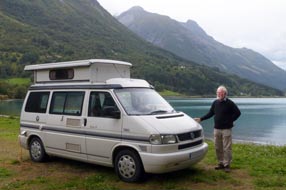|
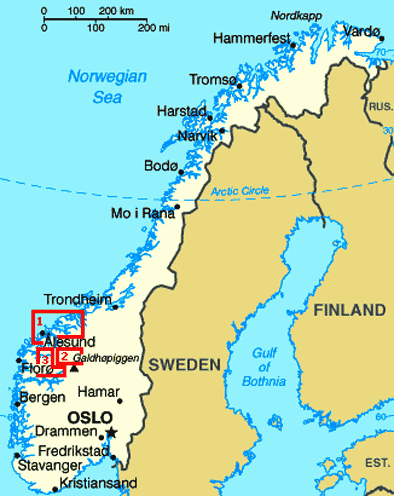 CAMPING
IN NORWAY 2014 - Kristiansund, the Atlantic Road to Molde, Åndalsnes,
Raumabanen railway
to Dombås, Trollveggen rock face, Ålesund,
and into fjord-land to Hellesylt, Geirangerfjord, Stryn and
Strynevatn: CAMPING
IN NORWAY 2014 - Kristiansund, the Atlantic Road to Molde, Åndalsnes,
Raumabanen railway
to Dombås, Trollveggen rock face, Ålesund,
and into fjord-land to Hellesylt, Geirangerfjord, Stryn and
Strynevatn:
Westwards on E39 to Kristiansund:
the onward E39 from Høgkjølen Camping across high fell-land was well-surfaced
and we were able to make good progress westward to a road junction. Here the
better road turned north leading to nowhere in particular, while E39 became more
narrow and poorly surfaced along the shore of the inner reaches of Vinjefjord.
The hilly peninsula on the far side of the fjord stretched away westwards, cut
through by side fjords to form 3 separate islands towards the tip. E39 crossed
side fjords to reach the large village of Vågalnd, turning south around the
shore of Skålviksfjord and out to the ferry dock at Halsa. From here the 20
minute ferry crossed Halsafjord to Kauestraum, and we joined the few vehicles
and couple of lorries already queuing as the 12-30 ferry was just docking.
|
Click on 3 highlighted areas of map for
details of
Western Norway |
 |
Krifast Mainland Connection of bridges and undersea
tunnel at Kristiansund:
over the Straumnes peninsula we crossed the Straumsund bridge to the
island of Aspøya, and around the southern shore reached the first of a trio of
modern civil engineering masterpieces that make up the ensemble of 2 mammoth
bridges and 5km long undersea tunnel, connecting the municipality of Kristiansund via Routes 70 and E39 to the neighbouring islands of Frei, Bergsøya
and Aspøya and the Norwegian mainland - the Krifast Mainland Connection (Kristiansund
fastlands-forbindelse) - see the
Map of the Krifast Mainland Connection to Kristiansund.
The Storting (Norwegian Parliament) authorised construction of the Krifast in October 1988, pledging
39% funding
of the cost with the remainder financed from car ferries during the construction
period and from tolls after completion. At July 1991 the project employed 427 people
and spent 2 million NOK daily on construction. 4 years and 1.1 billion NOK later
in August 1992, Krifast was opened for regular traffic. The balance of
construction costs was covered by tolls payment by December 2012 when the
bridges and tunnel became toll-free.
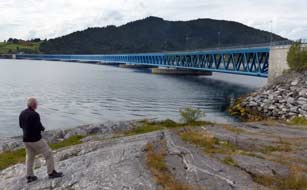 The Bergsøysund pontoon bridge:
we reached the first of the Krifast main bridges, the 933m (3,061 feet) long
Bergsøysund Bridge which connects the islands of Aspøya and Bergsøya in an
elegant sweeping curve (see left). The unique feature however of this magnificent structure
is that only its 2 ends are anchored into solid rock; the bridge's connecting
curvature is supported on 7 pontoons floating on the 320m deep, almost 1km wide Bergsøy Sound
(see below right). The significance of this pontoon structure was only apparent when
we parked in the lay-by and walked down to the flat fjord-side rocks. From this
vantage point, we had the perfect view looking The Bergsøysund pontoon bridge:
we reached the first of the Krifast main bridges, the 933m (3,061 feet) long
Bergsøysund Bridge which connects the islands of Aspøya and Bergsøya in an
elegant sweeping curve (see left). The unique feature however of this magnificent structure
is that only its 2 ends are anchored into solid rock; the bridge's connecting
curvature is supported on 7 pontoons floating on the 320m deep, almost 1km wide Bergsøy Sound
(see below right). The significance of this pontoon structure was only apparent when
we parked in the lay-by and walked down to the flat fjord-side rocks. From this
vantage point, we had the perfect view looking around the bridge's full sweeping
curvature with its steel lattice-work supporting the road-decking floating on
its 7 huge pontoons in the fjord and spread at regular intervals around the
bridge's 933m width
(Photo 1 - Bergsøysund pontoon bridge). Fishermen were casting their lines from the bridge's
parapet as we walked around to admire the structure. around the bridge's full sweeping
curvature with its steel lattice-work supporting the road-decking floating on
its 7 huge pontoons in the fjord and spread at regular intervals around the
bridge's 933m width
(Photo 1 - Bergsøysund pontoon bridge). Fishermen were casting their lines from the bridge's
parapet as we walked around to admire the structure.
The Gjemnessund suspension bridge:
we crossed the Bergsøysund pontoon bridge and drove around the southern coast of Bergsøya
to reach the next link in the Krifast Mainland Connection, the Gjemnessund
suspension bridge. Perhaps the most visually impressive of the Krifast bridges,
the Gjemnessund suspension bridge links the E39 from the SW tip of Bergsøya
island across to the much fragmented mainland of the Gjemnes municipality. Its
twin towers soar 108m (354 feet) high above the sound with a span of 623m (2,044
feet) between the towers, with the roadway decking arching upwards in an graceful
curve.
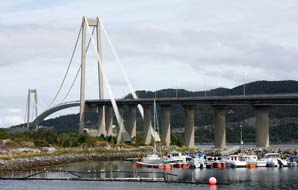 We pulled into a nearby parking area at the SW
tip of Bergsøya and walked down under the bridge's mighty piers; traffic passed
over the roadway high above with the noise of aircraft. This was such an
impressive spot from which to view the bridge's structure at close quarters; the
clusters of cable-stays anchored in concrete settings curved upwards towards the
bridges pylons. Being now toll-free, we could drive across the bridge without
charge, and began the long, steep climb under the first tower to the bridge's
lofty apex and down the far slope. Reaching the far shore, we turned off to a
small boat jetty for the panoramic view of the full sweep of this elegant
structure over a foreground of fishing boats
(see left) (Photo 2 - Gjemnessund suspension bridge). Beyond the end of the bridge's
southern approach, E39 disappeared into the mouth of a tunnel. The former road
still existed as a cycle route around to Molde avoiding the tunnel and running
around the coast past a church set on a high bluff overlooking the sound. The
church's graveyard gave a limited view of the bridge's western profile. We pulled into a nearby parking area at the SW
tip of Bergsøya and walked down under the bridge's mighty piers; traffic passed
over the roadway high above with the noise of aircraft. This was such an
impressive spot from which to view the bridge's structure at close quarters; the
clusters of cable-stays anchored in concrete settings curved upwards towards the
bridges pylons. Being now toll-free, we could drive across the bridge without
charge, and began the long, steep climb under the first tower to the bridge's
lofty apex and down the far slope. Reaching the far shore, we turned off to a
small boat jetty for the panoramic view of the full sweep of this elegant
structure over a foreground of fishing boats
(see left) (Photo 2 - Gjemnessund suspension bridge). Beyond the end of the bridge's
southern approach, E39 disappeared into the mouth of a tunnel. The former road
still existed as a cycle route around to Molde avoiding the tunnel and running
around the coast past a church set on a high bluff overlooking the sound. The
church's graveyard gave a limited view of the bridge's western profile.
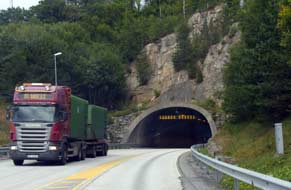 The Freifjord undersea tunnel:
re-crossing the suspension bridge, we now faced the 3rd of Krifast's major
structures, the 5.1km (3.2 miles) long Freifjord undersea tunnel, which passes
134m (440 feet) below the sea level of Freifjord Sound between the islands of Bergsøya
and Frei on Route 70's approach to Kristiansund (see right). The tunnel descends very
steeply for its first kilometre then levels out at its deepest point for 3kms
before rising steeply for its final kilometre to its exit on Frei island. The
1km ascent slopes at either end out of the tunnel's depths are both 3 lane
allowing overtaking of slow-moving traffic. It took 5 minutes to pass through
the undersea tunnel before we drove on across the width of Frei. The Freifjord undersea tunnel:
re-crossing the suspension bridge, we now faced the 3rd of Krifast's major
structures, the 5.1km (3.2 miles) long Freifjord undersea tunnel, which passes
134m (440 feet) below the sea level of Freifjord Sound between the islands of Bergsøya
and Frei on Route 70's approach to Kristiansund (see right). The tunnel descends very
steeply for its first kilometre then levels out at its deepest point for 3kms
before rising steeply for its final kilometre to its exit on Frei island. The
1km ascent slopes at either end out of the tunnel's depths are both 3 lane
allowing overtaking of slow-moving traffic. It took 5 minutes to pass through
the undersea tunnel before we drove on across the width of Frei.
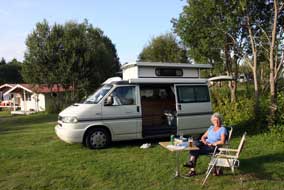 Alanten Turistsenter-Camping at Kristiansund: the port-town of Kristiansund is spread across a complex
of 3 islands, Nordland, Gomaland and Innland, with its harbour set in the sound
between the islands. Crossing Nordland, we passed several of the town's marine
engineering works which now support Norway's off-shore oil and gas industry.
Although at this stage, Kristiansund's topography was totally bemusing, our sat-nav
guided us over to Gomaland island and around the town's northern side, eventually
reaching Alanten Turistsenter and Camping, our base for our stay in
Kristiansund. The girl at reception was smilingly welcoming and helpful,
providing a town-plan, explaining the walk into Kristiansund and its places of
interest, and pointing out the camping areas and facilities hut; the nightly
all-inclusive charge of 200 NOK seemed almost too good to be true, but more of
that later! We selected a pitch only to discover that power points were
non-functional, and eventually settled into another corner, hoping this would be
quiet and looking forward to a much-needed day in camp tomorrow (see left). The evening was
more dusky than ever with the sun setting soon after 10-00pm and not rising
until 5-00am. Alanten Turistsenter-Camping at Kristiansund: the port-town of Kristiansund is spread across a complex
of 3 islands, Nordland, Gomaland and Innland, with its harbour set in the sound
between the islands. Crossing Nordland, we passed several of the town's marine
engineering works which now support Norway's off-shore oil and gas industry.
Although at this stage, Kristiansund's topography was totally bemusing, our sat-nav
guided us over to Gomaland island and around the town's northern side, eventually
reaching Alanten Turistsenter and Camping, our base for our stay in
Kristiansund. The girl at reception was smilingly welcoming and helpful,
providing a town-plan, explaining the walk into Kristiansund and its places of
interest, and pointing out the camping areas and facilities hut; the nightly
all-inclusive charge of 200 NOK seemed almost too good to be true, but more of
that later! We selected a pitch only to discover that power points were
non-functional, and eventually settled into another corner, hoping this would be
quiet and looking forward to a much-needed day in camp tomorrow (see left). The evening was
more dusky than ever with the sun setting soon after 10-00pm and not rising
until 5-00am.
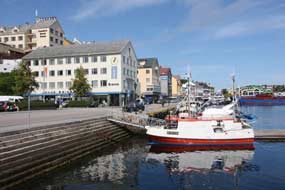 The following day we discovered the full scale
of Alanten Turistsenter and Camping's inadequacies, and the reason for its
apparently reasonable charge. The camping areas were careworn with inadequate or
unserviceable power supplies, and the facilities hopelessly limited: with just 2
WCs and showers for such a busy campsite, queues were inevitable; an apology for
a kitchen consisted of one outside wash-up sink and an electric ring, and
the wi-fi signal was too weak to reach the camping area. But the worst feature
was the abominable noise produced by the ventilation system which reverberated
around the entire camping area, making life intolerable for those camped nearby.
Our pitch around the corner escaped this noise but was not immune from the
overwhelmingly intrusive disturbance of The following day we discovered the full scale
of Alanten Turistsenter and Camping's inadequacies, and the reason for its
apparently reasonable charge. The camping areas were careworn with inadequate or
unserviceable power supplies, and the facilities hopelessly limited: with just 2
WCs and showers for such a busy campsite, queues were inevitable; an apology for
a kitchen consisted of one outside wash-up sink and an electric ring, and
the wi-fi signal was too weak to reach the camping area. But the worst feature
was the abominable noise produced by the ventilation system which reverberated
around the entire camping area, making life intolerable for those camped nearby.
Our pitch around the corner escaped this noise but was not immune from the
overwhelmingly intrusive disturbance of
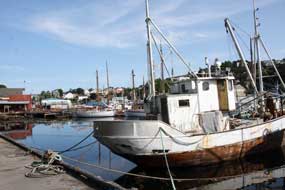 excavating diggers. Only the pleasant
welcome given by the young receptionist prevented the place from getting the
first negative rating of the trip! We put up with the noise levels and made the
most of our day in camp. excavating diggers. Only the pleasant
welcome given by the young receptionist prevented the place from getting the
first negative rating of the trip! We put up with the noise levels and made the
most of our day in camp.
Kristiansund: we woke to clear sky and sunny morning for our visit
to Kristiansund today, and set off to walk into the town. Set around its natural
harbour formed within the sound enclosed by the 3 islands across which the town
spreads, Kristiansund has prospered since the 17th century from cod fishing and
as a centre for the production of Klippfisk. The salted, dried cod was
processed traditionally by the town's womenfolk: gutted and de-headed while
the boats were still at sea, the flattened fish bodies were cleaned in the
shallows by the harbour (a desperate job in the freezing waters of winter),
salted and laid out to dry in the sun and wind on flat shore-side rocks;
this gave the dried cod the name Klippfisk from the Norwegian word
klipper meaning rocks. English merchants financed the klippfisk warehouses,
and a huge export trade developed with Portugal and Spain which still continues.
Today modern electric dryers have taken over from the traditional but
labour-intensive hand-washing and drying of yesteryear.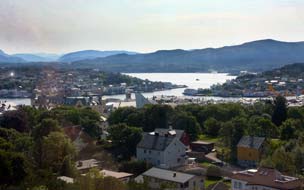
Kristiansund like so many Norwegian ports and
towns was bombed to total destruction by the Luftwaffe in April 1940, and 70% of
the town's building were reduced to ruins The town was rebuilt after the war,
and cod processing remains an important industry for Kristiansund with a large
proportion of Norway's Klippfisk exports produced in and around the town.
But since the discovery and exploitation of North Sea oil and gas, Kristiansund
has developed as one of Norway's major centres for servicing the oil and gas
rigs, with a huge partly state-financed terminal built just outside the town.
Our visit to Kristiansund: we walked down from the campsite to an
underpass where a pathway led past the marina and through what had been a 19th
century shipyard-museum, now more of a maritime junkyard full of the rusting
remains of ships (see above left). As a prelude to visiting the town and port, we walked from the
main street up through a park to find a route up to the Varden observation tower
on the hill top for its views over Kristiansund's islands and the Atlantic
coast. After what seemed an unending climb around pathways winding up the
hillside, we finally reached the ornamental white tower, surprised to find it
open and free. From its top, there was a panoramic view over the harbour (see
right), but more interestingly on the seaward side to the tiny island, skerries and
lighthouse of Grip. This former fishing settlement 14kms off the coast is now a
tourist attraction with boats from Kristiansund taking visitors out to the now
abandoned village.
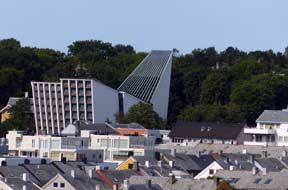 Back down into the city's main street Langveien we
visited the modern towered structure of the Kirkelandet church built in 1964 to
replace the town church flattened by WW2 German bombing (see left). The lines of the
church's plainly stark interior led the eye to the full height east-end stained glass
window
(Photo 3 - Kristiansund's Kirkelandet church)
(see right). As modern church architecture goes it Back down into the city's main street Langveien we
visited the modern towered structure of the Kirkelandet church built in 1964 to
replace the town church flattened by WW2 German bombing (see left). The lines of the
church's plainly stark interior led the eye to the full height east-end stained glass
window
(Photo 3 - Kristiansund's Kirkelandet church)
(see right). As modern church architecture goes it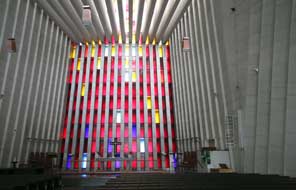 was certainly impressive, more so
than Bodø's ascetic concrete barn of a cathedral. Outside, rose gardens
scented the air as we walked down the street towards the main square of Kongens
Plass for details of the Atlantic road from the helpful TIC. The main street
turned off to the modern bridge crossing to Innlandet island, but we continued
ahead down to the harbour where 2 huge oil rig construction or servicing ships
over-topped with cranes were moored in the sound. Following the
waterfront around, we reached the main pier of Piren with the Kristiansund's iconic statue
of Klippfiskkjerringa, the fish-wife carrying her basket of klippfisk,
recalling the days of these poor women's hard labours washing the fish in
the freezing shallows and laying it to dry on the harbour rocks (Photo 4 - Klippfiskkjerringa statue by Kristiansund's waterfront). The romantic
imagery presented by the modern tourist industry belies the grim working
conditions and low pay of the fish-drying women whose toils lined the pockets of
fish merchants. As we sat to eat our sandwich lunch by the Piren war memorial,
the stumpy little Sundbåt harbour ferry pulled in at its pier-side mooring. Now
operated by Kristiansund Commune, the Sundbåts which chug back and forth across
the harbour between the town's 3 islands, are claimed as 'the world's oldest
public transport system in uninterrupted use'
(Photo 5 - Kristiansund's harbour ferry (Sundbåt))
(see below left). was certainly impressive, more so
than Bodø's ascetic concrete barn of a cathedral. Outside, rose gardens
scented the air as we walked down the street towards the main square of Kongens
Plass for details of the Atlantic road from the helpful TIC. The main street
turned off to the modern bridge crossing to Innlandet island, but we continued
ahead down to the harbour where 2 huge oil rig construction or servicing ships
over-topped with cranes were moored in the sound. Following the
waterfront around, we reached the main pier of Piren with the Kristiansund's iconic statue
of Klippfiskkjerringa, the fish-wife carrying her basket of klippfisk,
recalling the days of these poor women's hard labours washing the fish in
the freezing shallows and laying it to dry on the harbour rocks (Photo 4 - Klippfiskkjerringa statue by Kristiansund's waterfront). The romantic
imagery presented by the modern tourist industry belies the grim working
conditions and low pay of the fish-drying women whose toils lined the pockets of
fish merchants. As we sat to eat our sandwich lunch by the Piren war memorial,
the stumpy little Sundbåt harbour ferry pulled in at its pier-side mooring. Now
operated by Kristiansund Commune, the Sundbåts which chug back and forth across
the harbour between the town's 3 islands, are claimed as 'the world's oldest
public transport system in uninterrupted use'
(Photo 5 - Kristiansund's harbour ferry (Sundbåt))
(see below left).
 Along the main waterfront
passing 2 typically
ostentatious Russian cruise boats moored there and the rusty hulk of another oil
rig servicing vessel, we reached the Hurtigruten quay, but this was all locked
up and deserted until the south-bound liner arrived at 4-30 this afternoon. Back
along Along the main waterfront
passing 2 typically
ostentatious Russian cruise boats moored there and the rusty hulk of another oil
rig servicing vessel, we reached the Hurtigruten quay, but this was all locked
up and deserted until the south-bound liner arrived at 4-30 this afternoon. Back
along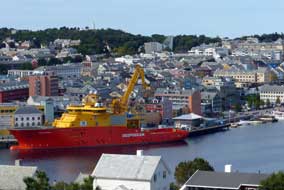 to Piren, we boarded the waiting Sundbåt to cross the harbour to
Gamle Byen on Innlandet. The honnør fare was 15 NOK and it took just a
couple of minutes to chug across the width of the harbour to the outer island,
and we spent a pleasant hour wandering around the lanes of the Old Town past all
the attractive and brightly coloured old wooden houses and cottages (Photo
6 - Gamle Byen wooden houses) (see below right). The view
from the hillside lanes down across the harbour made the climb worthwhile. Up
the hillside street, we located the path leading up onto the hill-top Bautaen
look-out point created in 1908 to mark the anniversary of a Napoleonic Wars
naval skirmish in 1808 when local militia had given a bloody nose to
2 Royal Navy frigates who saw the port of Kristiansund as an easy target for
attack. The path curved steeply up to the look-out which was duly decorated with
cannons from the 1908 celebrations, and gave a magnificent bird's eye panorama
over the town, its 3 islands and oil rig servicing ships (see right) (Photo
7 - Oil-rig servicing ship in Kristiansund harbour), and the stubby little Sundbåts crossing the harbour (Photo
8 - Sundbåt crossing Kristiansund harbour) (see below left). to Piren, we boarded the waiting Sundbåt to cross the harbour to
Gamle Byen on Innlandet. The honnør fare was 15 NOK and it took just a
couple of minutes to chug across the width of the harbour to the outer island,
and we spent a pleasant hour wandering around the lanes of the Old Town past all
the attractive and brightly coloured old wooden houses and cottages (Photo
6 - Gamle Byen wooden houses) (see below right). The view
from the hillside lanes down across the harbour made the climb worthwhile. Up
the hillside street, we located the path leading up onto the hill-top Bautaen
look-out point created in 1908 to mark the anniversary of a Napoleonic Wars
naval skirmish in 1808 when local militia had given a bloody nose to
2 Royal Navy frigates who saw the port of Kristiansund as an easy target for
attack. The path curved steeply up to the look-out which was duly decorated with
cannons from the 1908 celebrations, and gave a magnificent bird's eye panorama
over the town, its 3 islands and oil rig servicing ships (see right) (Photo
7 - Oil-rig servicing ship in Kristiansund harbour), and the stubby little Sundbåts crossing the harbour (Photo
8 - Sundbåt crossing Kristiansund harbour) (see below left).
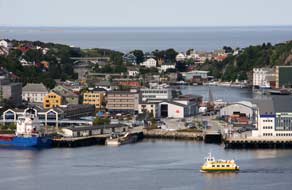 Back down the hill we boarded the 3-15pm Sundbåt
to cross firstly to the 3rd island of Nordlandet whose hillside was also lined
with attractive wooden houses, then on across the harbour to Gomalandet as the
coastal express ferry (Kystekspressen) from Trondheim arrived at the port.
The Sundbåt Back down the hill we boarded the 3-15pm Sundbåt
to cross firstly to the 3rd island of Nordlandet whose hillside was also lined
with attractive wooden houses, then on across the harbour to Gomalandet as the
coastal express ferry (Kystekspressen) from Trondheim arrived at the port.
The Sundbåt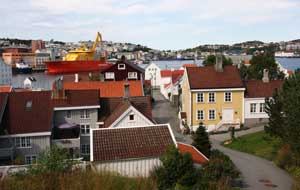 dropped us at the quay-stop by the Klippfisk Museum, our next
stopping point. Housed in a venerable old wooden fish warehouse, the Milnbrygge,
named after the 1772 English merchant owner Walter Miln (Photo
9 - Kristiansund Klippfisk Museum), the museum claims to
document the history of the klippfisk industry in Kristiansund from the 18th
century to post-WW2, and the thriving export trade of bacalao to
Mediterranean countries. The conserved wooden wharf was an admirable
masterpiece, which is more than could be said for the museum. You could wander
around parts of the un-translated exhibition and watch their klippfisk video for
free, or pay 70 NOK for an indifferent collection of old photos upstairs; the choice was an easy one! And that was the much promoted Klippfisk Museum. dropped us at the quay-stop by the Klippfisk Museum, our next
stopping point. Housed in a venerable old wooden fish warehouse, the Milnbrygge,
named after the 1772 English merchant owner Walter Miln (Photo
9 - Kristiansund Klippfisk Museum), the museum claims to
document the history of the klippfisk industry in Kristiansund from the 18th
century to post-WW2, and the thriving export trade of bacalao to
Mediterranean countries. The conserved wooden wharf was an admirable
masterpiece, which is more than could be said for the museum. You could wander
around parts of the un-translated exhibition and watch their klippfisk video for
free, or pay 70 NOK for an indifferent collection of old photos upstairs; the choice was an easy one! And that was the much promoted Klippfisk Museum.
Behind the Milnbrygge wharf, we clambered up onto
the flat rocks firstly to see the evident white staining from generations of
usage for drying klippfisk, and then to find a high vantage point with clear
view across the harbour from which to watch the arrival of the south-bound
Hurtigrute due at 4-30pm. In the distance the Hurtigrute's horn sounded
announcing its imminent arrival, and around the sound between Innlandet and
Kirkelandet, M/S Polarlys steamed majestically into Kristiansund harbour
(see below right) to dock at its quay immediately opposite where we stood on the klippfisk rocks (Photo
10 - Hurtigrute M/S Polarlys docking at Kristiansund).
We took our photos of the ship which we had seen earlier at the northern port of Berlevåg, then continued around towards the marina where from the quay-side we
watched M/S Polarlys back gracefully
from her mooring and sail away around the sound. Beyond a ship repair yard
where a rusty hulk was being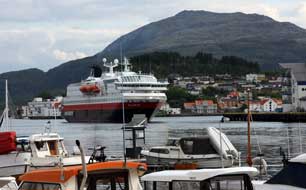 renovated, the lane led around the eastern side of
the harbour to our starting point from this morning, and back up to the
campsite. Today had given us a fascinating insight into Kristiansund's long cod
fishing and klippfisk processing traditions which continue today, its wartime
destruction and German occupation, and its modern day renewal and prosperity as
a major port and servicing centre for Norway's North Sea oil and gas exploitation
(see below left). It was
a gritty, hard-working and attractive port-city; we liked it a lot. renovated, the lane led around the eastern side of
the harbour to our starting point from this morning, and back up to the
campsite. Today had given us a fascinating insight into Kristiansund's long cod
fishing and klippfisk processing traditions which continue today, its wartime
destruction and German occupation, and its modern day renewal and prosperity as
a major port and servicing centre for Norway's North Sea oil and gas exploitation
(see below left). It was
a gritty, hard-working and attractive port-city; we liked it a lot.
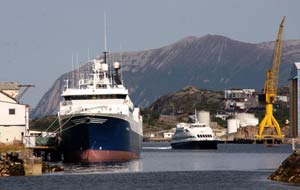 Byskogen Camping, Kristiansund: our original plan was to move
today, but rain had poured all night, and this morning the sky was dismally
overcast with rain cloud; it was still pouring. This certainly was not a day even
to contemplate the Atlantic Road, which tourist promotion describes as The
world's most beautiful drive. Given the forecast for continuing rain, the only
sensible thing was to sit it out in Kristiansund for another day and hope for
better weather tomorrow. We had chosen Alanten Turistsenter and Camping as a
base since it was within walking distance of the town, but with all the noise
disturbance and hopelessly inadequate, care-worn facilities, we decided to move
to Kristiansund's other campsite, Byskogen Camping over by the airfield. Having
re-stocked with provisions at a Co-op Extra hypermarket, we turned up to
Byskogen Camping. Set in a verdant grove surrounded by pine trees, the campsite
was deserted when we arrived. But the reception and service building were open
and facilities modern and clean with homely kitchen/common room and site-wide
wi-fi; we found a quiet corner of the camping area and settled in. The only
noise from the airfield was an occasional helicopter, rather more preferable
than the constant noise of diggers at Alanten Turistsenter! The weather remained overcast and the air
distinctly cooler, but the forecast was better for tomorrow when we should drive
the Atlantic Road around the spectacular west coast. Byskogen Camping, Kristiansund: our original plan was to move
today, but rain had poured all night, and this morning the sky was dismally
overcast with rain cloud; it was still pouring. This certainly was not a day even
to contemplate the Atlantic Road, which tourist promotion describes as The
world's most beautiful drive. Given the forecast for continuing rain, the only
sensible thing was to sit it out in Kristiansund for another day and hope for
better weather tomorrow. We had chosen Alanten Turistsenter and Camping as a
base since it was within walking distance of the town, but with all the noise
disturbance and hopelessly inadequate, care-worn facilities, we decided to move
to Kristiansund's other campsite, Byskogen Camping over by the airfield. Having
re-stocked with provisions at a Co-op Extra hypermarket, we turned up to
Byskogen Camping. Set in a verdant grove surrounded by pine trees, the campsite
was deserted when we arrived. But the reception and service building were open
and facilities modern and clean with homely kitchen/common room and site-wide
wi-fi; we found a quiet corner of the camping area and settled in. The only
noise from the airfield was an occasional helicopter, rather more preferable
than the constant noise of diggers at Alanten Turistsenter! The weather remained overcast and the air
distinctly cooler, but the forecast was better for tomorrow when we should drive
the Atlantic Road around the spectacular west coast.
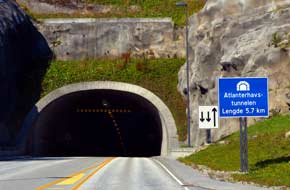 The Atlantic Ocean Undersea Tunnel to Averøya: after a peaceful night at Byskogen, we woke to a
clear sky and sunny morning. The morning internal flight for Oslo was just taking off as
we departed to drive back through the northern outskirts of Kristiansund and
turn off onto Route 64 at the entrance to the Atlanterhavs-tunnelen (Atlantic
Ocean Tunnel). The 5.7km (3.5 miles) long tunnel connecting Kristiansund's
Kirkelandet island to Averøya runs beneath Bremsnesfjord reaching a depth of
250m below sea level, making it one of the world's deepest undersea tunnels.
Construction began in 2006, breaking through in March 2009; problems with
rock-falls, cave-ins and water leaks caused delays (although when you are
driving through, you prefer not to know this!) and consequent cost-overrun, and
the tunnel opened in December 2009. The 1km long descent and ascent at a
gradient of 10% have dual lanes for overtaking. 70% of the tunnel's 635 million
NOK construction cost is to be recovered from tolls which are still in operation
with an anticipated pay-back period of 18 years. The Atlantic Ocean Undersea Tunnel to Averøya: after a peaceful night at Byskogen, we woke to a
clear sky and sunny morning. The morning internal flight for Oslo was just taking off as
we departed to drive back through the northern outskirts of Kristiansund and
turn off onto Route 64 at the entrance to the Atlanterhavs-tunnelen (Atlantic
Ocean Tunnel). The 5.7km (3.5 miles) long tunnel connecting Kristiansund's
Kirkelandet island to Averøya runs beneath Bremsnesfjord reaching a depth of
250m below sea level, making it one of the world's deepest undersea tunnels.
Construction began in 2006, breaking through in March 2009; problems with
rock-falls, cave-ins and water leaks caused delays (although when you are
driving through, you prefer not to know this!) and consequent cost-overrun, and
the tunnel opened in December 2009. The 1km long descent and ascent at a
gradient of 10% have dual lanes for overtaking. 70% of the tunnel's 635 million
NOK construction cost is to be recovered from tolls which are still in operation
with an anticipated pay-back period of 18 years.
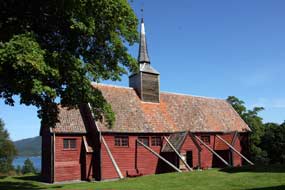 Kvernes stave church: we descended
into the tunnel at an alarming rate of fall and speed, thankful that Saturday
morning traffic was light; the re-ascent seemed even steeper. Emerging into
daylight at the toll-booths at the Averøya end, we faced a charge of 125 NOK (£12.50)
with no honnør reduction, our
contribution to the tunnel's construction cost recovery. We had also emerged
into an entirely different landscape from the Kristiansund islands: Averøya's knobbly, tree-covered fell-scape
looked delightful on a bright morning, especially against the exquisite blue of the Ocean away to our
right. A diversion brought us down to Bremnes quay from where the pre-tunnel
ferry had provided the only western road access to Kristiansund; today a sign warned
hopefuls that 'This ferry no longer operates' - so there! At the busy village of Bruhagen, we turned off from Route 64 onto the minor FV-247 lane which threaded
around the shore of Bremnesfjord down to the SE point of Averøya island and the
delightful farming village of Kvernes, where the ancient timber Kvernes
stave-church and its 19th century successor stood on the turf-lawned hill-side
looking out across the breadth of Kvernesfjord (see left). Kvernes stave church: we descended
into the tunnel at an alarming rate of fall and speed, thankful that Saturday
morning traffic was light; the re-ascent seemed even steeper. Emerging into
daylight at the toll-booths at the Averøya end, we faced a charge of 125 NOK (£12.50)
with no honnør reduction, our
contribution to the tunnel's construction cost recovery. We had also emerged
into an entirely different landscape from the Kristiansund islands: Averøya's knobbly, tree-covered fell-scape
looked delightful on a bright morning, especially against the exquisite blue of the Ocean away to our
right. A diversion brought us down to Bremnes quay from where the pre-tunnel
ferry had provided the only western road access to Kristiansund; today a sign warned
hopefuls that 'This ferry no longer operates' - so there! At the busy village of Bruhagen, we turned off from Route 64 onto the minor FV-247 lane which threaded
around the shore of Bremnesfjord down to the SE point of Averøya island and the
delightful farming village of Kvernes, where the ancient timber Kvernes
stave-church and its 19th century successor stood on the turf-lawned hill-side
looking out across the breadth of Kvernesfjord (see left).
 The stav-kirke at Kvernes
was built around 1300 (Photo
11 - Kvernes stave-church). The original church consisted of just the present nave,
its roof supported by 10 staves and its sturdy timber walls shored up by
external diagonal props. In 1663 the earlier stave-constructed chancel was
replaced by the present larger log-construction east-end, its walls decorated
with painted Biblical scenes, and a west-end The stav-kirke at Kvernes
was built around 1300 (Photo
11 - Kvernes stave-church). The original church consisted of just the present nave,
its roof supported by 10 staves and its sturdy timber walls shored up by
external diagonal props. In 1663 the earlier stave-constructed chancel was
replaced by the present larger log-construction east-end, its walls decorated
with painted Biblical scenes, and a west-end
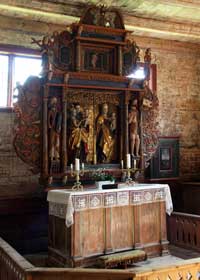 baptistery added. In the following
decade, the then pastor, Rev Anders Erikson, at his own expense had the nave and
baptistery walls and ceiling decorated with acanthus leaf paintings (Photo
12 - Kvernes stave church wall-paintings); remarkably
these decorations still survive though with some water damage. The stave-church
had passed from royal to parish ownership from the 18th century, and narrowly
survived demolition when the new church was built alongside in 1893. It was saved
and bought by the Society for Preservation of Ancient Monuments in 1893, and
today stands in remarkable condition with most of its original decoration still
intact. baptistery added. In the following
decade, the then pastor, Rev Anders Erikson, at his own expense had the nave and
baptistery walls and ceiling decorated with acanthus leaf paintings (Photo
12 - Kvernes stave church wall-paintings); remarkably
these decorations still survive though with some water damage. The stave-church
had passed from royal to parish ownership from the 18th century, and narrowly
survived demolition when the new church was built alongside in 1893. It was saved
and bought by the Society for Preservation of Ancient Monuments in 1893, and
today stands in remarkable condition with most of its original decoration still
intact.
The charming young guide nervously began her
description of the church's history and decorations, and showed us the church's
other treasures: a 300 year old votive ship said to have been plundered from a
Swedish church (see right), and the 15th century hybrid altar-piece, Catholic in origin with
carved figures of Mary and saints, which remarkably survived the Lutheran
bigotry of the Reformation having a florally decorated carved surround added in
1695 (see left). The chancel screen was decorated with the Danish King Christian IV's
royal monogram. We complemented this charmingly demur young lady for her
knowledgeable commentary and faultless command of
English, to which she modestly replied, "I had a good teacher". This was another delightfully
memorable encounter. We took our photographs inside and outside the
stave-church, and our eyes were also drawn in the opposite direction where the Gjemnessund
suspension bridge, which we had recently crossed, was just visible in the misty
distance across the fjord (Photo
13 - Gjemnessund suspension bridge across Bremnesfjord).
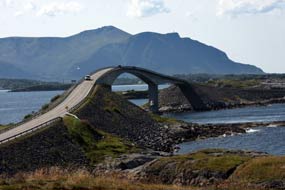 The
Atlantic Road: along the southern shore of Averøya, we passed a
series of dairy farms with cattle grazing and silage being cut or already
stacked in bales ready for next winter. It was a lovely peaceful setting,
looking out across Kvernesfjord to the mountainous mainland coast opposite. The
lane re-joined Route 64 at Karvåg at the start of the spectacular 8 km long
Atlantic Road, built over an archipelago of islands and skerries across the
mouth of Lauvøyfjord, linked by causeways and a sequence of 8 bridges, the most
prominent being the high-arching, artistically curving Storseisundet Bridge (see
right). The
route was originally planned as a railway line in the early 20th century, but
this project was abandoned. Planning of a road route began in 1970 and
construction began in 1983. During the 6 year construction period, the area was
hit by 12 hurricanes along this wildly exposed stretch of the Atlantic
coastline. The road opened in July 1989 at a total cost of The
Atlantic Road: along the southern shore of Averøya, we passed a
series of dairy farms with cattle grazing and silage being cut or already
stacked in bales ready for next winter. It was a lovely peaceful setting,
looking out across Kvernesfjord to the mountainous mainland coast opposite. The
lane re-joined Route 64 at Karvåg at the start of the spectacular 8 km long
Atlantic Road, built over an archipelago of islands and skerries across the
mouth of Lauvøyfjord, linked by causeways and a sequence of 8 bridges, the most
prominent being the high-arching, artistically curving Storseisundet Bridge (see
right). The
route was originally planned as a railway line in the early 20th century, but
this project was abandoned. Planning of a road route began in 1970 and
construction began in 1983. During the 6 year construction period, the area was
hit by 12 hurricanes along this wildly exposed stretch of the Atlantic
coastline. The road opened in July 1989 at a total cost of
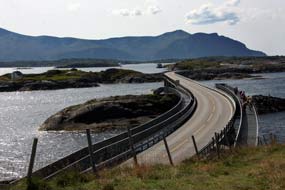 122 million NOK of
which 25% was to be financed by tolls, to be recovered over an expected 15 year
period. In fact, with greater than expected usage by both local and tourist
traffic, the debt had been paid off by 1999 when tolls ended. The Atlantic Road is now
designated as a National Tourist Route
and was voted Norwegian Construction Project of the Century in 2005 by the
Norwegian construction industry. Click here for a
Detailed map of the Atlantic Road 122 million NOK of
which 25% was to be financed by tolls, to be recovered over an expected 15 year
period. In fact, with greater than expected usage by both local and tourist
traffic, the debt had been paid off by 1999 when tolls ended. The Atlantic Road is now
designated as a National Tourist Route
and was voted Norwegian Construction Project of the Century in 2005 by the
Norwegian construction industry. Click here for a
Detailed map of the Atlantic Road
With the sun still shining brightly, we began our
transit of the Atlantic road from Karvåg over the 115m long Lille Lauvøysund
Bridge onto the island of Litllauvøya, then over the 52m long Store Lauvøysund
Bridge to Storlauvøya island. Across a causeway and the 52m long Geitøysundet
Bridge onto the island of Geitøya, we got the first distant glimpse of the
high-arching Storseisundet Bridge's renowned curvature. The road now curved
across the larger islands of Eldhusøya and Lyngholmen to reach the smaller
island of Ildhusøya, the closest point to the approaching curving bridge where
we pulled into a parking area. Here a cleverly constructed walk-way ran around
the outer seaward side of the islet giving perfect views of the curving Storseisundet
Bridge ahead. Sections of the fencing were low so that visitors could walk down
to the shore-line for closer views of the bridge. The islet's peaty moorland
surface was wet from recent rains and covered with heather, but by scrambling up
onto the high point we had the perfect 'helicopter' photographic view looking
across to the bridge
(Photo
14 - Storseisundet Bridge). The elegantly curving structure was by this time of early
afternoon still partly in shade; the time for photographing the bridge to best
advantage would have been early evening when the sun, further over to the west,
would light the face of Storseisundet Bridge.
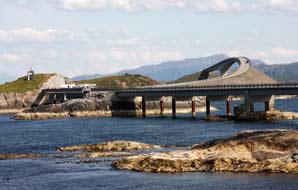 We began our crossing of steeply sloping,
curvature of Storseisundet Bridge, but as always the view from road level gave
little impression of the bridge's scale and artistic qualities. Across its
cantilevered 260m length onto Flatskjæret islet, we pulled into the next lay-by
and scrambled up onto the high point. This gave further views looking northwards
to Storseisundet Bridge, and to the south over the 3 interconnected sections of
Hulvågen Bridges which led 293m across onto Hulvågen island
(see above left) (Photo
15 - Three section Hulvågen Bridge). Walk-ways along
both sides of the bridges were crowded with fishermen. Across the 3 bridges to
the next island, we again paused at a lay-by where the shore-side rocks gave one
of the Road's best views looking northward across the Hulvågen Bridges backed by
the distant curvature of Storseisundet Bridge (see left and below right) (Photo
16 - Storseisundet Bridge from the south). The road now continued across the
larger islands of Skarvøya and Strausholmen, and over the 119m wide
Vevangstraumen Bridge finally to reach the Eida mainland at the hamlet of
Vevang. There inevitably was a lot of tourist traffic on a sunny Saturday
afternoon, but the route so ingeniously spanning the mouth of the mouth of Lauvøyfjord,
with its impressive array of bridges and viewpoints, had been a thoroughly
engaging experience. We had been very lucky having such clear weather for
today's spectacular journey. We began our crossing of steeply sloping,
curvature of Storseisundet Bridge, but as always the view from road level gave
little impression of the bridge's scale and artistic qualities. Across its
cantilevered 260m length onto Flatskjæret islet, we pulled into the next lay-by
and scrambled up onto the high point. This gave further views looking northwards
to Storseisundet Bridge, and to the south over the 3 interconnected sections of
Hulvågen Bridges which led 293m across onto Hulvågen island
(see above left) (Photo
15 - Three section Hulvågen Bridge). Walk-ways along
both sides of the bridges were crowded with fishermen. Across the 3 bridges to
the next island, we again paused at a lay-by where the shore-side rocks gave one
of the Road's best views looking northward across the Hulvågen Bridges backed by
the distant curvature of Storseisundet Bridge (see left and below right) (Photo
16 - Storseisundet Bridge from the south). The road now continued across the
larger islands of Skarvøya and Strausholmen, and over the 119m wide
Vevangstraumen Bridge finally to reach the Eida mainland at the hamlet of
Vevang. There inevitably was a lot of tourist traffic on a sunny Saturday
afternoon, but the route so ingeniously spanning the mouth of the mouth of Lauvøyfjord,
with its impressive array of bridges and viewpoints, had been a thoroughly
engaging experience. We had been very lucky having such clear weather for
today's spectacular journey.
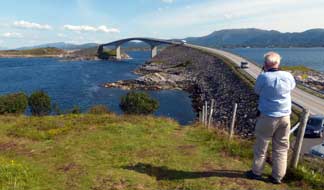 The fishing village of Bud and Bjølstad Camping: turning
off along a minor lane around Hustadvika Bay, the lane passed through farming
countryside, hamlets and the larger village of Farstad, winding its way around
the coast eventually to reach the large fishing village of Bud, where klippfisk
is still produced. We paused here and walked up to the preserved remains of a
huge WW2 German coastal battery on the headland looking down on Bud's fishing
harbour. Few boats seemed now to work from here, and these days tourism was
clearly the predominant industry.
Driving on along the coast through the small town of Elnesvågen, a
thoroughly unattractive place dominated by a huge chemical plant on the
fjord-side, we passed around the head of Malmefjord and turned off to tonight's
campsite, Bjølstad Camping. The place was sited on a steep hill-side sloping
down to the fjord with several terraced levels. We settled into the one
remaining space on a flatter level near to the service house. With its sloping
pitches, old-fashioned facilities, and worst of all noisy atmosphere, Bjølstad
Camping could at best only be described as mediocre, but would serve for an
overnight stop. The fishing village of Bud and Bjølstad Camping: turning
off along a minor lane around Hustadvika Bay, the lane passed through farming
countryside, hamlets and the larger village of Farstad, winding its way around
the coast eventually to reach the large fishing village of Bud, where klippfisk
is still produced. We paused here and walked up to the preserved remains of a
huge WW2 German coastal battery on the headland looking down on Bud's fishing
harbour. Few boats seemed now to work from here, and these days tourism was
clearly the predominant industry.
Driving on along the coast through the small town of Elnesvågen, a
thoroughly unattractive place dominated by a huge chemical plant on the
fjord-side, we passed around the head of Malmefjord and turned off to tonight's
campsite, Bjølstad Camping. The place was sited on a steep hill-side sloping
down to the fjord with several terraced levels. We settled into the one
remaining space on a flatter level near to the service house. With its sloping
pitches, old-fashioned facilities, and worst of all noisy atmosphere, Bjølstad
Camping could at best only be described as mediocre, but would serve for an
overnight stop.
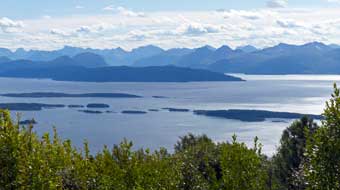 Molde and the panoramic peak-land view from
Varden viewpoint: back to Route 64 the following morning, we turned
south avoiding a toll tunnel through high fell-land by taking the old road
around a side-valley, to approach the small port-town of Molde. We parked at the
fjord-side central square to enquire at the TIC about the route up onto the
Varden viewpoint above the town. Following our marked-up street plan steeply
uphill through a residential area, we reached the end of the tarmaced lane; a
gravelled road rose even more steeply up the hill-side eventually ending at a
café on the hill's summit. From here the view across the town, fjord and islands
was truly breath-taking with a panoramic skyline to the south said to encompass
222 peaks (Photo
17 - Varden peak-lined panorama). We did not attempt to count them all but took our photos instead with
the now bright sunlight sparkling across the fjord and dramatic cloud-scape to
enhance the panorama of peaks (see left). Molde and the panoramic peak-land view from
Varden viewpoint: back to Route 64 the following morning, we turned
south avoiding a toll tunnel through high fell-land by taking the old road
around a side-valley, to approach the small port-town of Molde. We parked at the
fjord-side central square to enquire at the TIC about the route up onto the
Varden viewpoint above the town. Following our marked-up street plan steeply
uphill through a residential area, we reached the end of the tarmaced lane; a
gravelled road rose even more steeply up the hill-side eventually ending at a
café on the hill's summit. From here the view across the town, fjord and islands
was truly breath-taking with a panoramic skyline to the south said to encompass
222 peaks (Photo
17 - Varden peak-lined panorama). We did not attempt to count them all but took our photos instead with
the now bright sunlight sparkling across the fjord and dramatic cloud-scape to
enhance the panorama of peaks (see left).
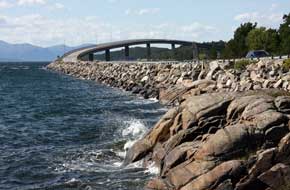 Across Fannefjord
and Langefjord by tunnel, bridge and ferry: beginning the
steep descent into Molde's northern suburbs, we re-joined Route 64 south and
immediately entered the 2.7 km long undersea Fannefjord Tunnel which passes at a
depth of 101m below sea level across to Bolsøya Island in the centre of the
fjord. Completed in 1991 to replace a former ferry, and partially financed by
tolls, the debt was cleared in 14 years and the tunnel became toll-free in 2005.
At the far side of the island, the road curved gracefully over the high-arching
Bolsøy Bridge. Having crossed, we pulled in to view the sweeping bridge from the
fjord-side rocks, with a brisk wind driving breakers onto the shore making an
attractive foreground (see right). We now had a 12kms drive around the western end of the
beautiful Skåla peninsula in the bright afternoon sunshine to catch the next
ferry across Langefjord from Sølsnes to Åfarnes; we made it just in time to drive
straight aboard the ferry which pulled out as we stopped. Across on the far
side, Route 64 hugged the eastern shore of Rødvenfjord which was enclosed on
both sides by pine-forested green fells. In the bright afternoon sunshine with
blue sky reflected in the waters of the fjord, it was a glorious drive. Across Fannefjord
and Langefjord by tunnel, bridge and ferry: beginning the
steep descent into Molde's northern suburbs, we re-joined Route 64 south and
immediately entered the 2.7 km long undersea Fannefjord Tunnel which passes at a
depth of 101m below sea level across to Bolsøya Island in the centre of the
fjord. Completed in 1991 to replace a former ferry, and partially financed by
tolls, the debt was cleared in 14 years and the tunnel became toll-free in 2005.
At the far side of the island, the road curved gracefully over the high-arching
Bolsøy Bridge. Having crossed, we pulled in to view the sweeping bridge from the
fjord-side rocks, with a brisk wind driving breakers onto the shore making an
attractive foreground (see right). We now had a 12kms drive around the western end of the
beautiful Skåla peninsula in the bright afternoon sunshine to catch the next
ferry across Langefjord from Sølsnes to Åfarnes; we made it just in time to drive
straight aboard the ferry which pulled out as we stopped. Across on the far
side, Route 64 hugged the eastern shore of Rødvenfjord which was enclosed on
both sides by pine-forested green fells. In the bright afternoon sunshine with
blue sky reflected in the waters of the fjord, it was a glorious drive.
 Rødven stave church: reaching the head of the fjord, we turned off onto
a narrow lane shelving above the fjord's western shore-line. After 10kms through
dairy farming country, we reached the scattered hamlet of Rødven and down by the
fjord we found the tiny wooden Rødven stave-church (Photo
18 - Rødven stave church) (see left). The main body of the tiny
wooden church was built around the early 1300s, perhaps replacing an even
earlier foundation, and was enlarged during the 17th century with some
decorative carvings and wall-paintings added. As at Kvernes, diagonal
side-supports were added at this time after storm damage threatened the church's
structural integrity. Windows were only added in the 19th century. The church
was smaller than Kvernes and lacked the same degree of elaborate wall paintings
and carved wooden works of art; it too had survived the bigotry of the Lutheran
Reformation, but there were none of the evident Catholic features which Kvernes
had managed to retain (Photo
19 - Interior of Rødven stave church). The graveyard ranged up the steep hillside giving a
vantage point from which to photograph the wooden church which glowed in the
afternoon sunlight against the backdrop of high green fells and blue fjord
waters. It was a truly beautiful and peaceful rural setting. Rødven stave church: reaching the head of the fjord, we turned off onto
a narrow lane shelving above the fjord's western shore-line. After 10kms through
dairy farming country, we reached the scattered hamlet of Rødven and down by the
fjord we found the tiny wooden Rødven stave-church (Photo
18 - Rødven stave church) (see left). The main body of the tiny
wooden church was built around the early 1300s, perhaps replacing an even
earlier foundation, and was enlarged during the 17th century with some
decorative carvings and wall-paintings added. As at Kvernes, diagonal
side-supports were added at this time after storm damage threatened the church's
structural integrity. Windows were only added in the 19th century. The church
was smaller than Kvernes and lacked the same degree of elaborate wall paintings
and carved wooden works of art; it too had survived the bigotry of the Lutheran
Reformation, but there were none of the evident Catholic features which Kvernes
had managed to retain (Photo
19 - Interior of Rødven stave church). The graveyard ranged up the steep hillside giving a
vantage point from which to photograph the wooden church which glowed in the
afternoon sunlight against the backdrop of high green fells and blue fjord
waters. It was a truly beautiful and peaceful rural setting.
Around Isfjord to Åndalsnes: returning around the narrow lane to Route
64, we rounded a neck of land into Isfjord where another spectacular mountainous
skyline of serrated peaks opened up to the south, with the port-town of
Åndalsnes visible in the distance on the southern shore of the fjord. But as we
drove along the fjord's northern shore-line, this tranquil setting was scarred
by the intrusive presence of a huge cruise ship anchored in the confines of Isfjord.
We were told later that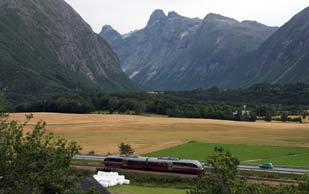 such cruise ships
regularly befoul Isfjord, overwhelming the tiny
port of Åndalsnes with massed tourists most days of the year. We rounded the head of the inlet at the village of Isfjord and, in heavy
traffic, returned along the south shore into Åndalsnes, eventually finding the
TIC down by the railway station at the terminus of the Raumabanen railway line.
The TIC had closed at 4-00pm but the ticket office was still open for us to
enquire about train times and ticket prices for our planned excursion on the
spectacular line up to Dombås. such cruise ships
regularly befoul Isfjord, overwhelming the tiny
port of Åndalsnes with massed tourists most days of the year. We rounded the head of the inlet at the village of Isfjord and, in heavy
traffic, returned along the south shore into Åndalsnes, eventually finding the
TIC down by the railway station at the terminus of the Raumabanen railway line.
The TIC had closed at 4-00pm but the ticket office was still open for us to
enquire about train times and ticket prices for our planned excursion on the
spectacular line up to Dombås.
Mjelva Camping in Romsdalen: back up
through the town, we turned off onto the E136 up Romsdalen towards Dombås to find
tonight's campsite Mjelva Camping, 6kms from Åndalsnes and set on a high
fell-land shelf overlooking the valley (Photo
20 - Mjelva Camping). We were greeted in a most
friendly and
hospitable manner by the owner who suggested a pitch with breathtaking views
looking up Romsdalen towards the stately skyline of the Trollveggen
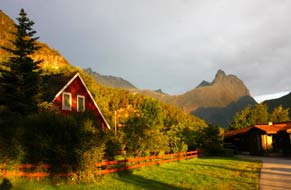 range and the
conical peak of Romsdalshornet (Photo
21 - Conical peak of Romsdalshornet). We
settled onto this terrace and enjoyed a relaxing hour sat outside admiring the
surrounding mountainous panorama and the massive rock wall rising up the
mountain-side behind us, as the late train from Dombås trundled down the valley
below our pitch (see above right); this was the perfect spot for our evening barbecue
with the view
looking along
Romsdalen towards the peak-line of Trollveggen
(Photo
22 - Mountain barbecue). The setting sun cast a fluorescent orange glow lighting the
serrated line of peaks up the valley and the horn-shaped peak of Romsdalshornet
(see left),
and tonight darkness really set in with an unbelievably large full-moon rising
above the peaks (see range and the
conical peak of Romsdalshornet (Photo
21 - Conical peak of Romsdalshornet). We
settled onto this terrace and enjoyed a relaxing hour sat outside admiring the
surrounding mountainous panorama and the massive rock wall rising up the
mountain-side behind us, as the late train from Dombås trundled down the valley
below our pitch (see above right); this was the perfect spot for our evening barbecue
with the view
looking along
Romsdalen towards the peak-line of Trollveggen
(Photo
22 - Mountain barbecue). The setting sun cast a fluorescent orange glow lighting the
serrated line of peaks up the valley and the horn-shaped peak of Romsdalshornet
(see left),
and tonight darkness really set in with an unbelievably large full-moon rising
above the peaks (see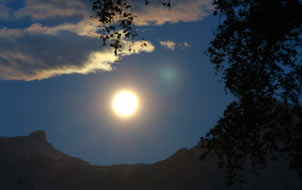 right).
right).
Romsdalen and the Raumabanen railway:
the following morning was overcast, but with an improvement forecast for
later, and a better day tomorrow for our ride on the Raumabanen, our plan for
today was to drive up Romsdalen to view the Trollveggen mountain walls and to
examine the key features of the Raumabanen Railway which enabled the line to
negotiate the higher reaches of the valley. We particularly wanted to photograph
a train passing over the spectacular Kylling Bridge spanning the gorge of the
Romsdal River. After a morning in camp, we set off up Romsdalen, the road and
railway running closely in parallel along the broad, flat-bottomed lower valley.
But 4 kms further, the mountain walls of the mighty Trollveggen range began to
close in totally overshadowing the narrowing valley. In today's overcast
lighting conditions, the mountain walls looked formidably gloomy and lacking in
detail. The now narrow road twisted and turned in the confines of the canyon,
criss-crossing the railway. As the mountain walls which enclosed the lower
valley on both sides opened out, the road began climbing with the river and
railway now running well below us in a wooded gorge.
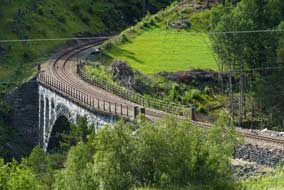 The Kylling Bridge: gaining much
height, the road reached the hamlet of Verma and just beyond the turning up to
Verma Station, we turned into a parking area by a shop-cum-café near to where
the railway line crosses the river gorge on the high-arching Kylling Bridge. A
footpath was signed to a lookout-point high above the river-gorge looking across
to the stone railway bridge. From the timetable, we could see that the afternoon
down train left Bjorli station some 10 minutes south of here at 2-44pm. With the
weather still gloomily overcast, we The Kylling Bridge: gaining much
height, the road reached the hamlet of Verma and just beyond the turning up to
Verma Station, we turned into a parking area by a shop-cum-café near to where
the railway line crosses the river gorge on the high-arching Kylling Bridge. A
footpath was signed to a lookout-point high above the river-gorge looking across
to the stone railway bridge. From the timetable, we could see that the afternoon
down train left Bjorli station some 10 minutes south of here at 2-44pm. With the
weather still gloomily overcast, we followed the footpath steeply down into
woods to reach a superbly positioned viewing point directly opposite the Kylling
Bridge. This magnificently iconic 76m (249 feet) long bridge, its main stone
arch having a span of 42m (138 feet), rose 59m (194 feet) above the river gorge
and waterfalls way down below (see left). Set among pine woods, this was a truly
magnificent setting; all we needed now was the red railcar of the Raumabanen
train to cross. followed the footpath steeply down into
woods to reach a superbly positioned viewing point directly opposite the Kylling
Bridge. This magnificently iconic 76m (249 feet) long bridge, its main stone
arch having a span of 42m (138 feet), rose 59m (194 feet) above the river gorge
and waterfalls way down below (see left). Set among pine woods, this was a truly
magnificent setting; all we needed now was the red railcar of the Raumabanen
train to cross.
We reached the lookout-point at 2-40pm, taking
trial photos in the gloomy light. Our watches ticked around to 2-44pm when the
train should be leaving Bjorli station, and we stood with cameras poised. With
the line emerging from Kylling Tunnel and hidden by trees immediately before
reaching the bridge-crossing, we should have little warning. The minutes ticked
around as we waited anxiously; had we mis-read the timetable? Then suddenly with
no warning, just after 3-00pm the train reached the bridge, rattling across at
speed without slowing (see above right). Our cameras snapped into action on continuous shoot; in a
flash the train had crossed the bridge and was lost from view
into the trees on the opposite side of the gorge. But we had our photos! (Photo
23 - Kylling Bridge)
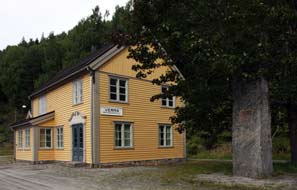 Verma Station and the 180º
curving Stavem Tunnel:
after crossing the Kylling Bridge, the railway line enters the 480m long Kylling
Tunnel, curving around through 90º on a gradient to gain further height up to
Verma Station. We walked
back along the road and climbed steeply up a side lane towards the
station with the line high above us. Two monuments stood beside the station: one
was a memorial to the 7 men who were killed during the Raumabanen line's 1912~24
construction; the other memorial bearing the royal coast of arms and Håkon VII's
monogram celebrated the line's official opening on 29 November 1924 (see left). The small
wooden station building by the trackside and passing loop bore the plaque:
Verma 273m høgd over havet (elevation above sea level) - 418,09km Oslo - 39.19 Åndalsnes.
Beyond the station the line curved away northwards towards Stavem Verma Station and the 180º
curving Stavem Tunnel:
after crossing the Kylling Bridge, the railway line enters the 480m long Kylling
Tunnel, curving around through 90º on a gradient to gain further height up to
Verma Station. We walked
back along the road and climbed steeply up a side lane towards the
station with the line high above us. Two monuments stood beside the station: one
was a memorial to the 7 men who were killed during the Raumabanen line's 1912~24
construction; the other memorial bearing the royal coast of arms and Håkon VII's
monogram celebrated the line's official opening on 29 November 1924 (see left). The small
wooden station building by the trackside and passing loop bore the plaque:
Verma 273m høgd over havet (elevation above sea level) - 418,09km Oslo - 39.19 Åndalsnes.
Beyond the station the line curved away northwards towards Stavem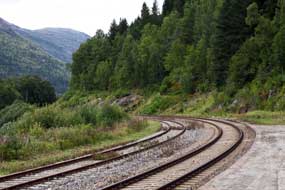 Tunnel, more of which later
(see right). The Raumabanen line was truly staggering piece of civil engineering
construction to drive a railway line through such impossibly inhospitable terrain. Tunnel, more of which later
(see right). The Raumabanen line was truly staggering piece of civil engineering
construction to drive a railway line through such impossibly inhospitable terrain.
Further Kylling Bridge photographs:
with the cloud thinning and sun just breaking through (unbelievably as
forecast), we just had enough time to return down the footpath to the
lookout-point for a further photograph of the 3-31pm up
train from Åndalsnes passing over the Kylling Bridge on its way to Dombås. We reached the lookout
at 3-55pm with the train due to reach the intermediate station of Bjorli at
4-15pm. Again we stood with cameras poised, but this time had even less warning
of the train's approach. Hidden by dense trees on the opposite side of the
gorge, the red railcar was there in a flash, but our cameras clicked away as it
sped over the bridge and disappeared into the tunnel. We walked back uphill with
a second set of photos!
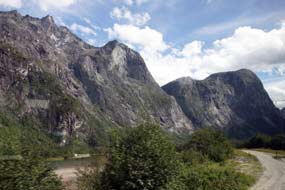 The rock faces of Trollveggen:
with a brighter sun now lighting the mountain sides, we drove down from the
upper valley back into the spectacular middle section of Romsdalen where the
mountain walls closed in to create a narrow canyon. On both sides of the road
sheer rock walls towered overhead, those rearing upwards on the eastern side now
fully lit by the afternoon sun. Further down valley however it was the
unbelievable towering rock walls of Trollveggen that really commanded attention.
The ice-smoothed gnarled buttresses rose immediately overhead ominously
threatening in dark shade, then rounding a another bend, sun caught the mountain
side highlighting details on this mighty rock face. It was a truly awe-inspiring
sight (see left). The rock faces of Trollveggen:
with a brighter sun now lighting the mountain sides, we drove down from the
upper valley back into the spectacular middle section of Romsdalen where the
mountain walls closed in to create a narrow canyon. On both sides of the road
sheer rock walls towered overhead, those rearing upwards on the eastern side now
fully lit by the afternoon sun. Further down valley however it was the
unbelievable towering rock walls of Trollveggen that really commanded attention.
The ice-smoothed gnarled buttresses rose immediately overhead ominously
threatening in dark shade, then rounding a another bend, sun caught the mountain
side highlighting details on this mighty rock face. It was a truly awe-inspiring
sight (see left).
We continued into Åndalsnes and parked down at the
port by the railway station (see below right) to buy tickets for our ride on the Raumabanen
tomorrow (Photo
24 - Åndalsnes port). The same helpful lady was on duty at the ticket office: there were no
honnør (senior's) reductions during the summer season on the Åndalsnes~Dombås
tourist trains and the full price of 496 NOK per person would make our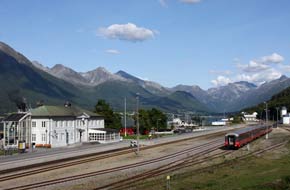 two return
fares almost £100! But she suggested a cheaper option: honnør reduced-price regular return tickets for Otta beyond Dombås cost only 316 NOK each; we need
only travel as far as Dombås before catching the return train. Such helpful
advice was much appreciated by us even if not by her employer, the Norwegian
State Railways!
two return
fares almost £100! But she suggested a cheaper option: honnør reduced-price regular return tickets for Otta beyond Dombås cost only 316 NOK each; we need
only travel as far as Dombås before catching the return train. Such helpful
advice was much appreciated by us even if not by her employer, the Norwegian
State Railways!
A ride on the Raumabanen Railway: we were away early the following
morning to be down at Åndalsnes station to catch the 9-27am Raumabanen train.
Visiting cruise ships were not expected until later in the week, but
to our horror the most monstrous of cruise ships was moored by the tiny port,
totally overwhelming the town; this was the embodiment of the very worst kind of
mass tourism, a floating miasma of 3,000 moronic souls milling aimlessly and
disorderly around the port. It was not the last time this trip we should
experience such exploitative invasiveness. The Raumabanen twin railcar was just
pulling into the platform as we arrived, and the guard-conductor shared our
revulsion at the cruise ship's objectionable disturbance at
the little port. Doubtless local businesses rub their greedy hands with glee at
the prospect of the daily invasion of massed ranks of gullible folk anxious to
give money away; not for sure the little community's local residents whose lives
are blighted by the intrusion. The train
pulled away to begin what is promoted as The world's most beautiful train
journey.
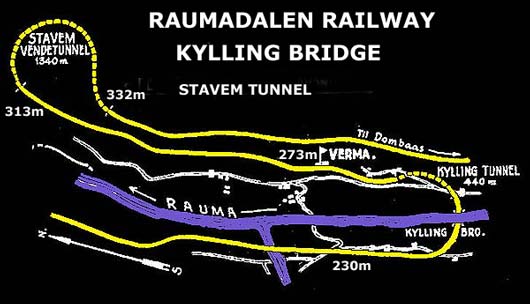 Following plans for the Oslo~Trondheim railway
line over Dovrefjell, there was pressure from the coastal municipalities for a
branch line out to the west coast, with intense rivalry between Kristiansund,
Molde and Ålesund as the proposed destination of the line's extension and the
route it would take. By 1910 the National Railway Board proposed a branch line
from Dombås down Romsdalen to Åndalsnes, the Rauma Line, and in 1912 the
Storting gave approval for the line to be built, with the long term aim of
extending it onwards to one of the west coast towns. Construction began in 1912
with navvies working on 4 geographical sections of the route and its
infrastructure. The line was opened in 3 stages: the initial 57kms from Dombås
to Bjorli in late 1921, the next 18kms from Bjorli to Verma in 1923, and the
whole line received its royal opening on 29 November 1924 with regular services Following plans for the Oslo~Trondheim railway
line over Dovrefjell, there was pressure from the coastal municipalities for a
branch line out to the west coast, with intense rivalry between Kristiansund,
Molde and Ålesund as the proposed destination of the line's extension and the
route it would take. By 1910 the National Railway Board proposed a branch line
from Dombås down Romsdalen to Åndalsnes, the Rauma Line, and in 1912 the
Storting gave approval for the line to be built, with the long term aim of
extending it onwards to one of the west coast towns. Construction began in 1912
with navvies working on 4 geographical sections of the route and its
infrastructure. The line was opened in 3 stages: the initial 57kms from Dombås
to Bjorli in late 1921, the next 18kms from Bjorli to Verma in 1923, and the
whole line received its royal opening on 29 November 1924 with regular services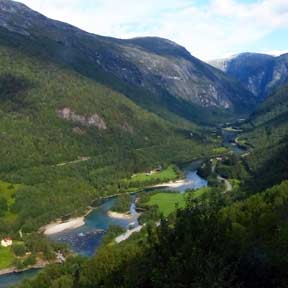 starting the following day. The Rauma Line over its 114km length from Dombås,
the line's highest point at 659m above sea level, down to Åndalsnes on the
coastal fjord at 4m above sea level, entails a drop in elevation of 655m. The
nature of the terrain, and achievement of gradients capable of being tackled by
steam locomotives of the day, meant severe challenges for construction engineers.
The line required a total of 103 bridges and 5 tunnels, but it was not just the
problem of spanning gorges with bridges. The greatest challenge was raising the
route up the 655m elevation gain on a satisfactory gradient in upper Romsdalen
(see right). This was achieved by the boldly conceived Stavem
Tunnel, which along its 1,396m length turns through a full 180º on a horseshoe
loop, to emerge further south in the opposite direction with a 19m gain in
elevation from 313m above sea level at its line of entry at the northern end of the tunnel
to 332m at its exit point. The tunnel
took 9 years of hard manual labour to construct and was bored from both ends;
given the 180º curvature and 3 dimensional raising of height, this was an
unbelievable piece of civil engineering (see map above left). But so precise was the surveying that
when the 2 ends joined up, the vertical and horizontal differences were a mere
3.5 cms out! For details of the Raumabanen, see the Norwegian
State Railways web site.
starting the following day. The Rauma Line over its 114km length from Dombås,
the line's highest point at 659m above sea level, down to Åndalsnes on the
coastal fjord at 4m above sea level, entails a drop in elevation of 655m. The
nature of the terrain, and achievement of gradients capable of being tackled by
steam locomotives of the day, meant severe challenges for construction engineers.
The line required a total of 103 bridges and 5 tunnels, but it was not just the
problem of spanning gorges with bridges. The greatest challenge was raising the
route up the 655m elevation gain on a satisfactory gradient in upper Romsdalen
(see right). This was achieved by the boldly conceived Stavem
Tunnel, which along its 1,396m length turns through a full 180º on a horseshoe
loop, to emerge further south in the opposite direction with a 19m gain in
elevation from 313m above sea level at its line of entry at the northern end of the tunnel
to 332m at its exit point. The tunnel
took 9 years of hard manual labour to construct and was bored from both ends;
given the 180º curvature and 3 dimensional raising of height, this was an
unbelievable piece of civil engineering (see map above left). But so precise was the surveying that
when the 2 ends joined up, the vertical and horizontal differences were a mere
3.5 cms out! For details of the Raumabanen, see the Norwegian
State Railways web site.
It was a fine, sunny morning for our journey on
the Raumadalen Railway, and the multilingual commentary described the key
features along the route. In the lower valley the train slowed for passengers to
admire Trollveggen's mighty mountain wall which rose a sheer 1,800m from valley
bottom to its crested pinnacles towering above the railway line which ran past
the foot of the cliffs (Photo
25- Trollveggen from Raumabanen train). The next feature was crossing the Kylling Bridge, which
we had watched from the view-point yesterday. But from the train windows, there
was little impression of the magnificent scale of this beautifully arched stone
bridge. We could only peer down into the gorge 59m below the track. The train
entered the Kylling Tunnel with the line curving through 90º and gaining
height on the steeply rising gradient raising the line up to the higher level of Verma Station. On a continuing rising gradient for a
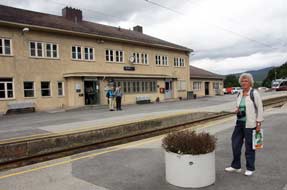 further km, the line
entered Stavem Tunnel, but from the train there was little sense of the line's
full 180º curve. It was only when the train emerged at the tunnel's southern end
that we could see the line faced in the opposite direction from entering the
tunnel; not only that but the approach line could be seen way down below at the
level of Verma Station. Even more startling however, the upward line on the far
side of the river gorge back from Kylling bridge which now came into view was
even lower, a clear revelation of just how much height gain the line had to
achieve at a reasonable climbing gradient in such a short distance (see above
right). Travelling now across high plateau fell-land, the train soon reached its
first stop at Bjorli Station, a scattered mountain village and winter sports
centre. The line now followed and crossed the Romsdals River which ran
vigorously along rocky gorges, until it reached the 11km long Lesjaskogvatnet
set on the watershed plateau with outflow rivers at both the eastern and western
ends. A short distance further and the train pulled into Dombås (Photo
26- Dombås station). further km, the line
entered Stavem Tunnel, but from the train there was little sense of the line's
full 180º curve. It was only when the train emerged at the tunnel's southern end
that we could see the line faced in the opposite direction from entering the
tunnel; not only that but the approach line could be seen way down below at the
level of Verma Station. Even more startling however, the upward line on the far
side of the river gorge back from Kylling bridge which now came into view was
even lower, a clear revelation of just how much height gain the line had to
achieve at a reasonable climbing gradient in such a short distance (see above
right). Travelling now across high plateau fell-land, the train soon reached its
first stop at Bjorli Station, a scattered mountain village and winter sports
centre. The line now followed and crossed the Romsdals River which ran
vigorously along rocky gorges, until it reached the 11km long Lesjaskogvatnet
set on the watershed plateau with outflow rivers at both the eastern and western
ends. A short distance further and the train pulled into Dombås (Photo
26- Dombås station).
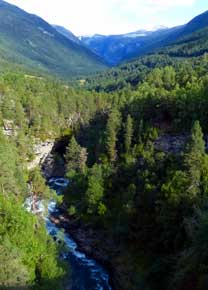 As was forecast, the weather up here at Dombås
659m above fjord-level was overcast and distinctly cooler. North of the station platforms, the 2
lines each disappeared into their separate tunnels, the main Trondheim line
NE-wards across Dovrefjell and the Raumabanen NW down to Åndalsnes. The main
line train from Trondheim onward to Oslo, which we should have changed to had we
used our tickets on to Otta, pulled in shortly. We now had just over an hour to
wait at Dombås before the Raumabanen train returned to Åndalsnes. Looking around
towards the town across the hillside, nothing seemed familiar from our visit to Dombås
on our northward journey which now seemed so long ago earlier in the trip. The
Oslo~Trondheim return train, which we should have caught back from Otta, in fact
was running over an hour late. Since it connected with the Raumabanen train, we
now had a further wait for our return to Åndalsnes. The Oslo train eventually
arrived, passengers transferred, and our train pulled out to return down into Romsdalen. We spent the journey through this magnificent scenery admiring the
skill of the railway engineers, and on the downward run there was a distinct
feeling of the Stavem Tunnel's 180º curve as the train rounded the horseshoe in
the tunnel's darkness. The other noticeable factor, looking out across the gorge
just after crossing the Kylling Bridge, was the markedly higher line descending
from the Stavem Tunnel's lower portal and perched high on the sheer face of the
mountainside. It was a truly remarkable engineering feat to have driven a
railway line on a rising gradient across what appeared the vertical face of the
mountain. Down through the middle~lower valley, through the narrowing canyon
enclosed by Trollveggen on the western side and Romdalshornet on the east,
the train returned to Åndalsnes, now in bright sunshine. The port area by the
station was awash with tourists from the cruise ship with nothing better to do
than to take snaps of one another by the fjord-side troll statue. As was forecast, the weather up here at Dombås
659m above fjord-level was overcast and distinctly cooler. North of the station platforms, the 2
lines each disappeared into their separate tunnels, the main Trondheim line
NE-wards across Dovrefjell and the Raumabanen NW down to Åndalsnes. The main
line train from Trondheim onward to Oslo, which we should have changed to had we
used our tickets on to Otta, pulled in shortly. We now had just over an hour to
wait at Dombås before the Raumabanen train returned to Åndalsnes. Looking around
towards the town across the hillside, nothing seemed familiar from our visit to Dombås
on our northward journey which now seemed so long ago earlier in the trip. The
Oslo~Trondheim return train, which we should have caught back from Otta, in fact
was running over an hour late. Since it connected with the Raumabanen train, we
now had a further wait for our return to Åndalsnes. The Oslo train eventually
arrived, passengers transferred, and our train pulled out to return down into Romsdalen. We spent the journey through this magnificent scenery admiring the
skill of the railway engineers, and on the downward run there was a distinct
feeling of the Stavem Tunnel's 180º curve as the train rounded the horseshoe in
the tunnel's darkness. The other noticeable factor, looking out across the gorge
just after crossing the Kylling Bridge, was the markedly higher line descending
from the Stavem Tunnel's lower portal and perched high on the sheer face of the
mountainside. It was a truly remarkable engineering feat to have driven a
railway line on a rising gradient across what appeared the vertical face of the
mountain. Down through the middle~lower valley, through the narrowing canyon
enclosed by Trollveggen on the western side and Romdalshornet on the east,
the train returned to Åndalsnes, now in bright sunshine. The port area by the
station was awash with tourists from the cruise ship with nothing better to do
than to take snaps of one another by the fjord-side troll statue.
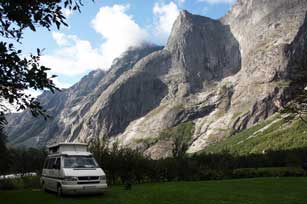 Trollveggen Camping set at the foot of the Trollveggen rock wall: thankfully we returned
to the peace of Romsdalen for our final night in the valley at Trollveggen
Camping. The camping area was pleasantly laid out with peaceful, grassy pitches
among the trees alongside the fast-flowing Rauma River. But the most stunningly
spectacular feature was the setting, immediately at the foot of the 1000m high
rock wall and crenulated crested ridge-line of Trollveggen. Contrary to our
fears, there was plenty of space, and we selected a peaceful pitch in the
furthest corner giving the clearest view looking directly up at Europe's
greatest rock wall (see left). Before settling in we drove further up valley to the Trollveggen Visitor Centre. This however was another world away from the wild
nature it claimed to represent: an unrestrained mecca of mass tourism, sordidly rampant and over-commercialised materialistic greed. The car park was
filled by a whole fleet of tour-buses ferrying the occupants of the ghastly
cruise ship which overwhelmed Åndalsnes' little port. The so-called Visitor
Centre was nothing more than an over-sized gift shop where mindless souls milled
around looking for trolls and aimlessly spending their money on the basest of
ephemeral trash. The only worthwhile feature of the place was the film show with
archive footing on the history of climbing and parachute jumping on Trollveggen's rock wall. Unsure which was worse, the unrestrained commercialism
or the flocks of brainless clientele milling around, we got out as fast as we
could and returned to the peaceful sanctuary of Trollveggen Camping (Photo
27- Trollveggen Camping). Trollveggen Camping set at the foot of the Trollveggen rock wall: thankfully we returned
to the peace of Romsdalen for our final night in the valley at Trollveggen
Camping. The camping area was pleasantly laid out with peaceful, grassy pitches
among the trees alongside the fast-flowing Rauma River. But the most stunningly
spectacular feature was the setting, immediately at the foot of the 1000m high
rock wall and crenulated crested ridge-line of Trollveggen. Contrary to our
fears, there was plenty of space, and we selected a peaceful pitch in the
furthest corner giving the clearest view looking directly up at Europe's
greatest rock wall (see left). Before settling in we drove further up valley to the Trollveggen Visitor Centre. This however was another world away from the wild
nature it claimed to represent: an unrestrained mecca of mass tourism, sordidly rampant and over-commercialised materialistic greed. The car park was
filled by a whole fleet of tour-buses ferrying the occupants of the ghastly
cruise ship which overwhelmed Åndalsnes' little port. The so-called Visitor
Centre was nothing more than an over-sized gift shop where mindless souls milled
around looking for trolls and aimlessly spending their money on the basest of
ephemeral trash. The only worthwhile feature of the place was the film show with
archive footing on the history of climbing and parachute jumping on Trollveggen's rock wall. Unsure which was worse, the unrestrained commercialism
or the flocks of brainless clientele milling around, we got out as fast as we
could and returned to the peaceful sanctuary of Trollveggen Camping (Photo
27- Trollveggen Camping).
Trollveggen is Europe's highest vertical rock
face, stretching a full 1,800m (almost 6,000 feet) from its foot in the valley
to the tallest of its crested peaks Store Trolltind. 1000m of this height is
vertical rock wall with a 50m overhang at its top
(Photo
28 - Store Trolltind) (see below left). This is supreme rock climbing
territory with a number of classic climbing routes spread across the face. The
longest route Trollryggen was first climbed in 1958 and was the first rock route
in Norway on which climbers had to bivouac overnight on the mountain face. In
1980 a new 'sport' developed here at Trollveggen when the Finnish parachutist
Jorma Öster leapt off the crest at Bruraskaret into a sky-dive to parachute land
in the valley 6,000 feet below. This challenging feat became more popular during
the early 1980s but as a result of several fatal accidents and dangerous
helicopter rescue missions, so-called BASE-jumping was prohibited by law from
Trollveggen. And here we sat at the foot of the mountain face looking directly
up at this mighty vertical rock wall towering above us. So impressively
attention-demanding was Trollveggen that the eye almost failed to take in that
immediately behind us another rock wall, that of Romsdalshornet's mighty bulk,
rose vertically enclosing the eastern side of the canyon-like valley in which we
were camped. Trollveggen's main gulley immediately above us was filled with a
cone of debris material, perhaps overlaying a core of glacial lateral moraine
and topped by streaks of recent scree. At risk stiff necks, we could gaze up at
the full width and height of all of Trollveggen's classic climbing routes,
topped by its crenulated ridge of peaks, and the gap from which the BASE-jumpers
had leapt into space from the cliff.
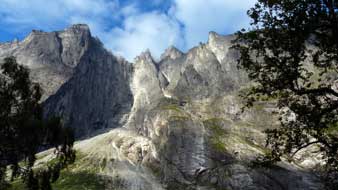 It is impossible to convey in words the
full scale and impact of this unbelievable mountain wall. Suffice to say that,
with this uninterrupted view of Trollveggen's line of cliffs, this was one of
the most memorable spots we had ever camped at. It is impossible to convey in words the
full scale and impact of this unbelievable mountain wall. Suffice to say that,
with this uninterrupted view of Trollveggen's line of cliffs, this was one of
the most memorable spots we had ever camped at.
As we sat eating breakfast the following morning,
the cloud began to break, with gradually increasing sun lighting the
formidable cliffs and buttresses of Trollveggen's rock face. Across at the
campsite's tent area, even closer to the foot of the rock wall, we discovered
the cause of the roaring sound that had filled the air: the Rauma River ran its
white-water course through a rocky gorge immediately below the rock-fall debris
and moraine cone at the base of the main rock face which towered overhead,
making the perfect photographic composition from the top of Trollveggen's
crested skyline way above, down the vertical rock face with its overhang, down
again to the top of the rock debris cone, itself 2,000 feet in height, down yet again into
its wooded footings, and finally down to the Rauma River's white water torrent (Photo
29 - Trollveggen Mountain Wall) (see above right).
It was a truly monumental spectacle. But gathering cloud brought our
photographic session to an end and we turned our attention to more practical
jobs and prepared to move on.
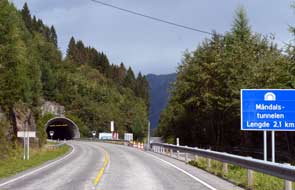 Westwards to Ålesund: back down-valley to Åndalsnes, we turned off westwards on
E136 through tunnels, around the Innfjord inlet and the main body of
Romsdalsfjord, over to the long inlet of Trestfjord. A new bridge being
constructed across the width of Trestfjord was incomplete, meaning a long drive
around the head of the fjord. Partway along the western shore, E136 joined E39
coming in from Molde to gain height over high fell-land and a long descent on
the western slopes down Landedalen to the small town of Sjøholt. The road
continued westwards along a narrow isthmus leading to the long crab's
claw-shaped narrow peninsula with Ålesund perched at its NW extremity. Reaching
the town of Spjelkavik, we faced a confusingly complex series of road junctions
and the busiest and most stressful traffic encountered in the whole of Norway.
Thankful for the sat-nav's reassuring guidance, we worked our way through
westwards eventually to approach Ålesund, to turn off into Volsdalen
Camping. Being a small campsite, there was little space, but we found not so
much a pitch but a gravelled parking area; the owner however welcomed us with
helpful hospitality even offering a discount for our camping card (unprecedented
in Norway!). Westwards to Ålesund: back down-valley to Åndalsnes, we turned off westwards on
E136 through tunnels, around the Innfjord inlet and the main body of
Romsdalsfjord, over to the long inlet of Trestfjord. A new bridge being
constructed across the width of Trestfjord was incomplete, meaning a long drive
around the head of the fjord. Partway along the western shore, E136 joined E39
coming in from Molde to gain height over high fell-land and a long descent on
the western slopes down Landedalen to the small town of Sjøholt. The road
continued westwards along a narrow isthmus leading to the long crab's
claw-shaped narrow peninsula with Ålesund perched at its NW extremity. Reaching
the town of Spjelkavik, we faced a confusingly complex series of road junctions
and the busiest and most stressful traffic encountered in the whole of Norway.
Thankful for the sat-nav's reassuring guidance, we worked our way through
westwards eventually to approach Ålesund, to turn off into Volsdalen
Camping. Being a small campsite, there was little space, but we found not so
much a pitch but a gravelled parking area; the owner however welcomed us with
helpful hospitality even offering a discount for our camping card (unprecedented
in Norway!).
 Ålesund and its Jugenstil architecture: the fishing and ferry port of Ålesund
has a distinctly different appearance from other Norwegian towns, as a result of
a devastating fire which destroyed the wooden buildings of the entire central
part of the town in 1904, leaving 10,000 of its 12,000 inhabitants homeless. A
reconstruction programme got underway immediately with emergency assistance and
shiploads of building materials and foodstuffs sent from Germany by Kaiser
Wilhelm II. At a time of economic depression and high unemployment in Norway,
craftsmen and labourers arrived from all over the country in the hope of finding
work. Young, nationalistically-minded Norwegian architects, trained mainly in
Germany, redesigned the new town in the characteristic Jugenstil style popular at
the time, but adding Nordic themes. The result was that Ålesund acquired the
distinctive art nouveau appearance seen today along the streets of the
central area around the port (Photo
30 - Ålesund's Jugenstil architecture). Ålesund and its Jugenstil architecture: the fishing and ferry port of Ålesund
has a distinctly different appearance from other Norwegian towns, as a result of
a devastating fire which destroyed the wooden buildings of the entire central
part of the town in 1904, leaving 10,000 of its 12,000 inhabitants homeless. A
reconstruction programme got underway immediately with emergency assistance and
shiploads of building materials and foodstuffs sent from Germany by Kaiser
Wilhelm II. At a time of economic depression and high unemployment in Norway,
craftsmen and labourers arrived from all over the country in the hope of finding
work. Young, nationalistically-minded Norwegian architects, trained mainly in
Germany, redesigned the new town in the characteristic Jugenstil style popular at
the time, but adding Nordic themes. The result was that Ålesund acquired the
distinctive art nouveau appearance seen today along the streets of the
central area around the port (Photo
30 - Ålesund's Jugenstil architecture).
 Given that it was only 3-00pm, we decided to walk
into the centre for a preliminary visit to Ålesund this afternoon. The campsite
owner provided us with a town booklet and directions, assuring us it was only a
1.5km walk. Beyond the sports stadium, a footbridge led over the busy E136,
through a residential area with some wooden cottages which must have survived
the fire, and into the centre. Ålesund is crammed onto the narrowest part of the
westward-facing peninsula which rises steeply along its central spine. The
central streets therefore rise steeply up from the port with a stepped path
leading to a viewpoint atop the hill. Reaching the centre, we followed Kaiser
Wilhelm gata, named after the town's benefactor, and up Storgata to find 2 of
the characteristically Jugenstil streets, Løvenvoldgata and Kongensgata; but
apart from a couple of buildings Given that it was only 3-00pm, we decided to walk
into the centre for a preliminary visit to Ålesund this afternoon. The campsite
owner provided us with a town booklet and directions, assuring us it was only a
1.5km walk. Beyond the sports stadium, a footbridge led over the busy E136,
through a residential area with some wooden cottages which must have survived
the fire, and into the centre. Ålesund is crammed onto the narrowest part of the
westward-facing peninsula which rises steeply along its central spine. The
central streets therefore rise steeply up from the port with a stepped path
leading to a viewpoint atop the hill. Reaching the centre, we followed Kaiser
Wilhelm gata, named after the town's benefactor, and up Storgata to find 2 of
the characteristically Jugenstil streets, Løvenvoldgata and Kongensgata; but
apart from a couple of buildings
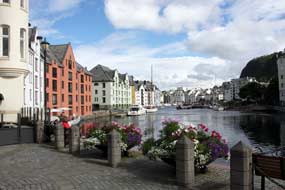 with decorative floral motifs
(see right) (Photo
31- Art Nouveau florally decorated building), the style about
which the tourist literature makes so much was not particularly engaging.
Thankfully the area was pedestrianised since traffic around the centre was
intense, made worse by tour buses weaving around the narrow streets filled with
tourists from yet another cruise ship moored the port. Around the waterfront, a
bridge linked across Brosundet with view of the art nouveau buildings clustered
on the central island
(see left) (Photo 32 - Ålesund's harbour frontage). Most prominent of these was the turreted former pharmacy,
now the Jugenstil Senter Museum which, if you are prepared to pay the excessive
admission charge (we weren't!) tells the story of Ålesund's Jugenstil
reconstruction. Instead, we walked around the corner and steeply up Latinskola
gata to view at no charge the Grammar School's façade which embodied all the
characteristic features of the Nordic Jugenstil style with animal reliefs and
floral designs decorating the building's lines (Photo
33 - Jugenstil style Latinskola) (see below right). with decorative floral motifs
(see right) (Photo
31- Art Nouveau florally decorated building), the style about
which the tourist literature makes so much was not particularly engaging.
Thankfully the area was pedestrianised since traffic around the centre was
intense, made worse by tour buses weaving around the narrow streets filled with
tourists from yet another cruise ship moored the port. Around the waterfront, a
bridge linked across Brosundet with view of the art nouveau buildings clustered
on the central island
(see left) (Photo 32 - Ålesund's harbour frontage). Most prominent of these was the turreted former pharmacy,
now the Jugenstil Senter Museum which, if you are prepared to pay the excessive
admission charge (we weren't!) tells the story of Ålesund's Jugenstil
reconstruction. Instead, we walked around the corner and steeply up Latinskola
gata to view at no charge the Grammar School's façade which embodied all the
characteristic features of the Nordic Jugenstil style with animal reliefs and
floral designs decorating the building's lines (Photo
33 - Jugenstil style Latinskola) (see below right).
Volsdalen Camping at Ålesund: although pleasantly located looking out
across the inner fjord coast, Volsdalen Camping was a dreary place overlooked by
a neighbouring apartment block. Being the only campsite left at Ålesund, it was
the most crowded and noisy car park we had camped in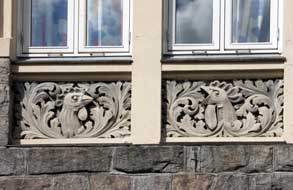 the whole trip, a
singularly unattractive place filled with ill-mannered, rowdy folk showing no
neighbourly consideration for others. The facilities were modern with
well-intentioned, integrated bathroom design, but simply insufficient meaning
queues. Having said that, the owner was helpful and
welcoming. So underwhelmed
were we yesterday afternoon by Ålesund's over-promoted but unexceptional
Jugenstil architecture and its overcrowding with the whole trip, a
singularly unattractive place filled with ill-mannered, rowdy folk showing no
neighbourly consideration for others. The facilities were modern with
well-intentioned, integrated bathroom design, but simply insufficient meaning
queues. Having said that, the owner was helpful and
welcoming. So underwhelmed
were we yesterday afternoon by Ålesund's over-promoted but unexceptional
Jugenstil architecture and its overcrowding with
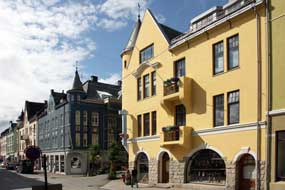 traffic and tourists, we were
tempted to give today's visit a miss and move on. But having discovered the
buses that ran regularly from the nearby shops into the centre, we gave Ålesund
a second chance. The 5 minute bus ride dropped us at Kaiser Bill Street by the
bus station, and we began a circular walk around the central area best known for
its Jugenstil architecture. traffic and tourists, we were
tempted to give today's visit a miss and move on. But having discovered the
buses that ran regularly from the nearby shops into the centre, we gave Ålesund
a second chance. The 5 minute bus ride dropped us at Kaiser Bill Street by the
bus station, and we began a circular walk around the central area best known for
its Jugenstil architecture.
From the Jugenstil Senter by the harbour, we set
off along Apotekergata in the now bright sunshine and soon began passing more
attractive art nouveau buildings with more distinctive features than seen
yesterday
(see left) (Photo
34 - Ålesund's Art Nouveau buildings). Around at Aksel Holms plass, another art nouveau building, now a
hotel, bore the date of 1905 completed just one year after the great fire (see
below left).
Around Molovegan we reached the outer harbour and just around the corner
opposite the Fisheries Museum, we found several attractive wooden cottages which
had managed to survive the fire. Next door a glass workshop promoted its wares
and we went inside to watch the young glass blower working on ornate pieces of
glasswork, hoisting the blowing pole around with a globule of red hot molten
glass on the tip
(see right) (Photo
35 - Ålesund glass-blower). It was impressive to watch, but neither the ornate style or
prices of the finished work appealed!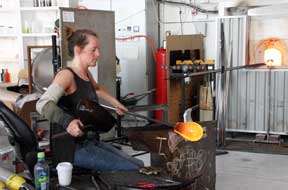
We ventured up steps on the steep hillside that
brought us onto the upper part of the old town and a viewpoint. From here we
could look down over the
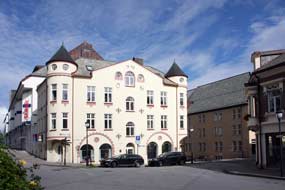 harbour with the high spine of the Ålesund peninsula
rising beyond (Photo
36 - Ålesund's harbour). Back along past the church, built in 1909 to replace the one
destroyed by the fire, we found streets with more art nouveau buildings
(Photo
37 - Kirkegata Jugenstil buildings), and
returned to the centre to re-photograph in today's better light the buildings of Kongensgata. More than the much promoted Jugenstil architecture, what for us
characterised Ålesund was the intensity of the town traffic and the price of
parking; throughout the length of Norway, we had not seen another town so
traffic-infested. That, and the number of tourists from the cruise ships which
totally dominated the port like monstrous maritime skyscrapers, made Ålesund a
less than appealing place whose art nouveau architecture failed to live up to
the tourist hype. harbour with the high spine of the Ålesund peninsula
rising beyond (Photo
36 - Ålesund's harbour). Back along past the church, built in 1909 to replace the one
destroyed by the fire, we found streets with more art nouveau buildings
(Photo
37 - Kirkegata Jugenstil buildings), and
returned to the centre to re-photograph in today's better light the buildings of Kongensgata. More than the much promoted Jugenstil architecture, what for us
characterised Ålesund was the intensity of the town traffic and the price of
parking; throughout the length of Norway, we had not seen another town so
traffic-infested. That, and the number of tourists from the cruise ships which
totally dominated the port like monstrous maritime skyscrapers, made Ålesund a
less than appealing place whose art nouveau architecture failed to live up to
the tourist hype.
Sjøbakken Camping at Sykkylven:
leaving Ålesund with afternoon traffic heavier than ever, our route turned down
to the peninsula's south coast for the ferry port of Magerholm. The ferry across
to Sykkylven was full to capacity, and with dark storm clouds filling the sky we
sat in the camper for the 15 minute crossing of the huge Storfjord with little
impression of the surrounding gloomy mountains. This was the busiest ferry
crossing we had experienced and at the far port of Ørsnest, long queues of
traffic waited for the return crossing. With rain now falling and black clouds
masking the mountains, we drove along Sykkylvsfjord into the little town
of Sykkylven. This curious little town spread
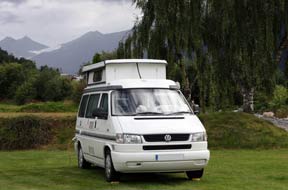 along the fjord-side is apparently
a major centre of furniture manufacturing, including the factory making the
designer Stressless Chairs, not that we had ever heard of these; their web site
shows illustrations, all looking like ... well chairs! Appropriately Sykkylven
houses the Norwegian Furniture Museum. In the town's southern outskirts we
reached tonight's campsite Sjøbakken Camping. There were 2 small camping areas
terraced into the hillside overlooking the fjord, and the owner came over to
welcome us, telling us about the town and the fjord's fishing potential. The
rain had eased but on such a gloomy evening not only did dusk settle early, but
full darkness; long gone were the light evenings this far south at 62ºN,
and that evening we even had the heater on. along the fjord-side is apparently
a major centre of furniture manufacturing, including the factory making the
designer Stressless Chairs, not that we had ever heard of these; their web site
shows illustrations, all looking like ... well chairs! Appropriately Sykkylven
houses the Norwegian Furniture Museum. In the town's southern outskirts we
reached tonight's campsite Sjøbakken Camping. There were 2 small camping areas
terraced into the hillside overlooking the fjord, and the owner came over to
welcome us, telling us about the town and the fjord's fishing potential. The
rain had eased but on such a gloomy evening not only did dusk settle early, but
full darkness; long gone were the light evenings this far south at 62ºN,
and that evening we even had the heater on.
After heavy overnight rain, the following morning
was gloomily overcast but we were looking forward to a day in camp (see right). Facilities at Sjøbakken were basic in the extreme and there was no kitchen other than a
primitive outside wash-up sink; but all this seemed acceptable with the 190 NOK
charge quoted in their web site. When it came to settling up however, the owner demanded
225 NOK claiming disingenuously that his web site was out of date and failed to
mention a per person charge; with an extra 10 NOK each for showers, this
totalled 245 NOK, an outrageous charge for what was a very basic site with
primitive facilities. His deceitful greed caused much offence, and Sjøbakken Camping was rated -2 accordingly, a place to avoid!
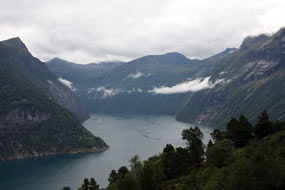 South to Hellesylt and Geirangerfjord:
the weather forecast for the next few days, when we were heading for what was
scenically some of the most attractive parts of fjord-land, was far from good;
much rain was forecast. Route 60 headed south from Sykkylven past the end of the
fjord gaining height steeply in tight sweeping curves up Velledalen. Once beyond
the watershed, the road began a long, equally steep descent into a narrow valley
to Stranda where we shopped for the coming weekend. With the weather still
gloomily overcast, Route 60 climbed steadily up the alpine farming valley of
Strandadalen. Ahead the dark mountainous massif seemed to present an impassable
barrier to further progress, but the road soon entered a 3km long tunnel,
unnervingly narrow and poorly lit,. We were thankful to emerge into daylight at
the far end, and pulled over into a lay-by on the outer side of the road for the
bird's eye view looking down across the steep-sided Sunnylvsfjord, the
innermost extension of the mighty Storfjord. The dull weather made what would
otherwise have been a stunning view disappointingly murky. A little further a
newly built viewpoint gave even better views looking directly into the mouth of
the renowned Geirangerfjord which branches off westwards enclosed by sheer,
vertical-sided mountain walls. Again poor light marred what would have been a
perfect photographic vantage point (see left). The Geirangerfjord ferry was just South to Hellesylt and Geirangerfjord:
the weather forecast for the next few days, when we were heading for what was
scenically some of the most attractive parts of fjord-land, was far from good;
much rain was forecast. Route 60 headed south from Sykkylven past the end of the
fjord gaining height steeply in tight sweeping curves up Velledalen. Once beyond
the watershed, the road began a long, equally steep descent into a narrow valley
to Stranda where we shopped for the coming weekend. With the weather still
gloomily overcast, Route 60 climbed steadily up the alpine farming valley of
Strandadalen. Ahead the dark mountainous massif seemed to present an impassable
barrier to further progress, but the road soon entered a 3km long tunnel,
unnervingly narrow and poorly lit,. We were thankful to emerge into daylight at
the far end, and pulled over into a lay-by on the outer side of the road for the
bird's eye view looking down across the steep-sided Sunnylvsfjord, the
innermost extension of the mighty Storfjord. The dull weather made what would
otherwise have been a stunning view disappointingly murky. A little further a
newly built viewpoint gave even better views looking directly into the mouth of
the renowned Geirangerfjord which branches off westwards enclosed by sheer,
vertical-sided mountain walls. Again poor light marred what would have been a
perfect photographic vantage point (see left). The Geirangerfjord ferry was just beginning
its passage along this spectacularly narrow fjord, and just as we were leaving
the Hurtigrute liner moved slowly below us on its excursion into Storfjord and
Geirangerfjord (Photo
38 - Hurtigrute M/S Midnattsol entering Geirangerfjord) (see
right). Through binoculars we could see it was our old friend M/S
Midnatsol; this was the third time we had seen her this trip, firstly
departing northwards from Trondheim, secondly on her southward passage from
Brønnøysund, and now here at Geirangerfjord. This made the perfect photograph of
Geirangerfjord with Midnatsol just entering the mouth of the narrow
fjord. beginning
its passage along this spectacularly narrow fjord, and just as we were leaving
the Hurtigrute liner moved slowly below us on its excursion into Storfjord and
Geirangerfjord (Photo
38 - Hurtigrute M/S Midnattsol entering Geirangerfjord) (see
right). Through binoculars we could see it was our old friend M/S
Midnatsol; this was the third time we had seen her this trip, firstly
departing northwards from Trondheim, secondly on her southward passage from
Brønnøysund, and now here at Geirangerfjord. This made the perfect photograph of
Geirangerfjord with Midnatsol just entering the mouth of the narrow
fjord.
The road shelving high on the sheer-sided cliff
above the fjord now entered a 3km long tunnel, this one newly cut, wide and
well-lit, a joy to pass through. Just beyond its southern portal, we turned off
steeply down into the village-port of Hellesylt at the western end of
Geirangerfjord. Round at the ferry dock, we confirmed details of tomorrow's
round-trip by ferry along Geirangerfjord from Hellesylt to Geiranger. Hellesylt
was a peaceful place but with a curiously passé air, its once grandiose Grand
Hotel by the ferry dock looking now rather woebegone. Perhaps Geiranger at the
eastern end of the fjord, highly promoted by the mass tourism industry, these
days attracts all the visitors; or perhaps it was something to do with the threat of
a great chunk of Åknes peak collapsing into Storfjord and swamping
Hellesylt with the resulting tsunami, as happened at Tafjord in 1934 when the
village was destroyed by a 16m tidal wave caused by massive rock-falls into
Nordallsfjord killing 23 residents.
 Stadheimfossen Camping:
a couple of kms along the valley from Hellesylt, we reached tonight's campsite,
Stadheimfossen Camping; even on an overcast day, this tiny campsite looked instantly appealing, set
alongside its noisily rushing river and eponymous waterfalls (see left). The owner welcomed
us with a laid-back greeting, pointing out the camping area: settle yourselves
in and I'll be back later to sort out the paper-work, he said. We camped in a
corner by the river, with the roar of the waterfalls filling the air. The
facilities were reasonable and the nightly charge a good value 215 NOK; this was
a charmingly peaceful and welcoming spot to camp. Stadheimfossen Camping:
a couple of kms along the valley from Hellesylt, we reached tonight's campsite,
Stadheimfossen Camping; even on an overcast day, this tiny campsite looked instantly appealing, set
alongside its noisily rushing river and eponymous waterfalls (see left). The owner welcomed
us with a laid-back greeting, pointing out the camping area: settle yourselves
in and I'll be back later to sort out the paper-work, he said. We camped in a
corner by the river, with the roar of the waterfalls filling the air. The
facilities were reasonable and the nightly charge a good value 215 NOK; this was
a charmingly peaceful and welcoming spot to camp.
Ferry along Geirangerfjord: we were away early on an overcast
morning for the 9-30am ferry trip along Geirangerfjord, and leaving George in
Hellesylt, we walked round to the ferry-dock. The waiting ferry was quite large
and could carry a number of vehicles including tour-buses, but on this early
passage was quite empty. The topmost viewing deck gave good all-round views as
the ferry moved out to cross into the mouth of Geirangerfjord. Although
overcast, the weather was bright with puff-balls of cloud hovering around the
mountainous cliffs enclosing the narrow winding fjord.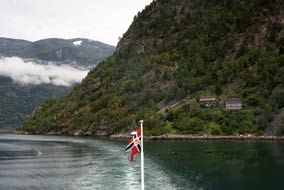 Geirangerfjord is 250m
(600 feet) deep and 20kms in length, its partly wooded, vertical rocky mountain
sides narrowing towards its inner end. During the 19th century, farming settlers
founded farms unbelievably perched on ledges along the sheer cliff sides of the
fjord, eking out a subsistence living farming goats and in one case growing
apples and apricots on the south-facing slopes at the more open end of the
fjord. These hardy settlers were originally attracted to this improbable farming
location by the low cost of such inhospitable terrain and by the peacefulness of
this remote, isolated location. The last of these farms was abandoned in the
1960s but the farm buildings clinging precariously to the cliff faces have been
preserved. Today however the peacefulness is long gone: Geiranger and its fjord
is
exploited beyond belief by the modern mass tourism industry at its most
rapacious. As well as tour buses crawling over the vertiginous hairpins of the
approach roads, some 150 cruise ships each year invade the village-port of Geiranger which nestles at the head of its narrow fjord, the ships moored out
the fjord polluting the pure mountain air with their diesel fumes and choking
the tiny village with throngs of tourists. By comparison, Hellesylt at the
opposite end of the fjord is still a haven of peace. Geirangerfjord is 250m
(600 feet) deep and 20kms in length, its partly wooded, vertical rocky mountain
sides narrowing towards its inner end. During the 19th century, farming settlers
founded farms unbelievably perched on ledges along the sheer cliff sides of the
fjord, eking out a subsistence living farming goats and in one case growing
apples and apricots on the south-facing slopes at the more open end of the
fjord. These hardy settlers were originally attracted to this improbable farming
location by the low cost of such inhospitable terrain and by the peacefulness of
this remote, isolated location. The last of these farms was abandoned in the
1960s but the farm buildings clinging precariously to the cliff faces have been
preserved. Today however the peacefulness is long gone: Geiranger and its fjord
is
exploited beyond belief by the modern mass tourism industry at its most
rapacious. As well as tour buses crawling over the vertiginous hairpins of the
approach roads, some 150 cruise ships each year invade the village-port of Geiranger which nestles at the head of its narrow fjord, the ships moored out
the fjord polluting the pure mountain air with their diesel fumes and choking
the tiny village with throngs of tourists. By comparison, Hellesylt at the
opposite end of the fjord is still a haven of peace.
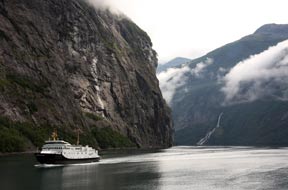 A mountain walk at Geiranger: our
ferry chugged slowly along the surprisingly winding Geirangerfjord (Photo
39 - Ferry along Geirangerfjord), its recorded
multilingual commentary pointing out the remains of isolated farms perched high
on ledges on the sheer slops of the rocky side walls. Further along, we passed
the Seven Sisters waterfalls which with spring melt-waters would have been a
truly magnificent sight dropping in a broad fan-tailed cascade 700 feet down the
sheer cliff; today however in late summer, the falls were barely a trickle.
Approaching Geiranger, the 11 spectacular hairpins of Route 63 Ørnevegen (Eagles
Way), which forces a passage over the mountains from Åndalsnes, were clearly
visible. The ferry docked at Geiranger, and fortunately today no cruise ships
were contaminating the little port with their diesel fumes and hoards of
tourists. The village nestled into the little cove at the fjord's end with its
wooden houses tiered up the steep hillside and crowded campsite spread around
the shore's edge (Photo
40 - Port-village of Geiranger). Somewhat bemused by the utter incongruity of all this mass
tourism in such a monumental location, we secured a map-leaflet from A mountain walk at Geiranger: our
ferry chugged slowly along the surprisingly winding Geirangerfjord (Photo
39 - Ferry along Geirangerfjord), its recorded
multilingual commentary pointing out the remains of isolated farms perched high
on ledges on the sheer slops of the rocky side walls. Further along, we passed
the Seven Sisters waterfalls which with spring melt-waters would have been a
truly magnificent sight dropping in a broad fan-tailed cascade 700 feet down the
sheer cliff; today however in late summer, the falls were barely a trickle.
Approaching Geiranger, the 11 spectacular hairpins of Route 63 Ørnevegen (Eagles
Way), which forces a passage over the mountains from Åndalsnes, were clearly
visible. The ferry docked at Geiranger, and fortunately today no cruise ships
were contaminating the little port with their diesel fumes and hoards of
tourists. The village nestled into the little cove at the fjord's end with its
wooden houses tiered up the steep hillside and crowded campsite spread around
the shore's edge (Photo
40 - Port-village of Geiranger). Somewhat bemused by the utter incongruity of all this mass
tourism in such a monumental location, we secured a map-leaflet from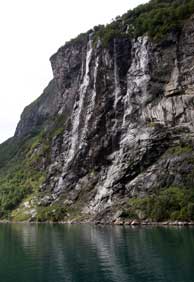 the TIC.
The best of the walk options seemed to be the 2km, 250m height gain path leading
up to one of the former mountain farms perched high above Geiranger. Steeply up
through the village, cutting through the graveyard of the tiny octagonal wooden
church, our path branched off just opposite the pretentious-looking Norwegian
Fjord Centre. The ground was still wet from recent rains and the path climbed with remorseless steepness up though woodland; this tediously
grinding slog gained the 250m of height with no views through the dense trees,
and with little reward for the effort we were tempted to give up. But the trees
finally thinned and ahead the farm buildings of what was once Vesterås farm came
into view still high above. We contoured round below steep pastureland the TIC.
The best of the walk options seemed to be the 2km, 250m height gain path leading
up to one of the former mountain farms perched high above Geiranger. Steeply up
through the village, cutting through the graveyard of the tiny octagonal wooden
church, our path branched off just opposite the pretentious-looking Norwegian
Fjord Centre. The ground was still wet from recent rains and the path climbed with remorseless steepness up though woodland; this tediously
grinding slog gained the 250m of height with no views through the dense trees,
and with little reward for the effort we were tempted to give up. But the trees
finally thinned and ahead the farm buildings of what was once Vesterås farm came
into view still high above. We contoured round below steep pastureland
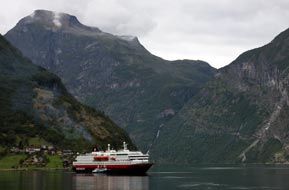 where sheep
and goats grazed, eventually reaching a path sloping up to the farm. After a
pause for lunch sandwiches looking down into the valley way below, we began the
descent retracing our steps down through the wet pastureland; at one point we
found wild hops, perhaps once grown by the farm settlers to brew beer to pass
the long winters in this isolated mountain eyrie. We made faster progress down
the steep, stony path than on our plodding ascent and were soon back at the
road. As we came down through the village, today's Hurtigrute could be seen
moving slowly up the fjord; it was M/S Nordlys seen earlier in the trip
at the Barents Sea port of Kjøllefjord. The ship moored out in the fjord and a
bum-boat chugged out to ferry passengers into the quay where buses were waiting
to take them tour-about. Our 2-00pm ferry had already docked and we went aboard
to await our return along the fjord as the Hurtigrute departed. where sheep
and goats grazed, eventually reaching a path sloping up to the farm. After a
pause for lunch sandwiches looking down into the valley way below, we began the
descent retracing our steps down through the wet pastureland; at one point we
found wild hops, perhaps once grown by the farm settlers to brew beer to pass
the long winters in this isolated mountain eyrie. We made faster progress down
the steep, stony path than on our plodding ascent and were soon back at the
road. As we came down through the village, today's Hurtigrute could be seen
moving slowly up the fjord; it was M/S Nordlys seen earlier in the trip
at the Barents Sea port of Kjøllefjord. The ship moored out in the fjord and a
bum-boat chugged out to ferry passengers into the quay where buses were waiting
to take them tour-about. Our 2-00pm ferry had already docked and we went aboard
to await our return along the fjord as the Hurtigrute departed.
Thankful to be away from the crowds and back at
the comparatively peaceful Hellesylt, we drove back along the little farming
valley for a second night at the delightful Stadheimfossen Camping where our
quiet corner by the waterfalls awaited us.
The isolated valley of Norangsdalen: after heavy overnight rain,
the overcast sky cleared as we were having breakfast and a weak sun shone
through a passing downpour to produce a magnificent double rainbow spanning the entire lower end of
the valley and linking the side mountains (Photo
41 - Rainbow over Stadheimfossen Camping). Turning south from Hellesylt, we took
 the minor Route 655 up into the lonely and little-visited Norangsdalen. This gem
of a hidden valley runs for 24kms connecting Hellesylt with the Leknes~Sæbø
Ferry close to the hamlet of Øye on the attractive and less populated
Hjørundfjord. The lower southern end of the valley had several large dairy
farms, but beyond the vegbom the road became narrow and single-track and
the surroundings more foreboding with high, craggy mountains closing in on both
sides, giving the dark valley a majestic but eerie feel in today's overcast
light. This was some of the wildest scenery we had travelled through: high and
uncertain mountain walls the minor Route 655 up into the lonely and little-visited Norangsdalen. This gem
of a hidden valley runs for 24kms connecting Hellesylt with the Leknes~Sæbø
Ferry close to the hamlet of Øye on the attractive and less populated
Hjørundfjord. The lower southern end of the valley had several large dairy
farms, but beyond the vegbom the road became narrow and single-track and
the surroundings more foreboding with high, craggy mountains closing in on both
sides, giving the dark valley a majestic but eerie feel in today's overcast
light. This was some of the wildest scenery we had travelled through: high and
uncertain mountain walls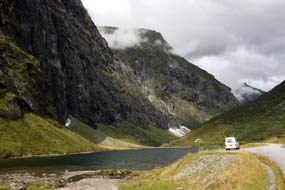 reared up on both sides with high cones of scree at
their foot, and the boulder-strewn valley floor littered with rock debris gave
grim evidence of frequent rock-falls (Photo
42 - Norangsdalen). We advanced apprehensively up the valley,
reaching a dark mountain tarn and the ruined stone crofts of what was once Urasætra, one of several transhumance farmsteads where in the 19th and early 20th centuries
local dairy maids spent the summer with their cattle in the summer pastures. A
little further by another of the mountain lakes, a row of 5 tiny stone-built
crofts were preserved, snuggled into the shelter of boulders for protection
against rock-falls from the overshadowing mountain walls above (Photo
43 - Transhumance farming crofts). This must have
been a desperately lonely and hardy lifestyle. We continued down into the lower
northern end of the valley to reach Lygnstøylvatnet, a darkly forbidding small lake created in 1908 when a major
landslide dammed the stream's natural outflow with boulders and rock debris,
inundating several farms as the waters backed up forming the new lake. The
remains of the farm shacks could still be seen on the bed of the clear, shallow
lake (see below left). reared up on both sides with high cones of scree at
their foot, and the boulder-strewn valley floor littered with rock debris gave
grim evidence of frequent rock-falls (Photo
42 - Norangsdalen). We advanced apprehensively up the valley,
reaching a dark mountain tarn and the ruined stone crofts of what was once Urasætra, one of several transhumance farmsteads where in the 19th and early 20th centuries
local dairy maids spent the summer with their cattle in the summer pastures. A
little further by another of the mountain lakes, a row of 5 tiny stone-built
crofts were preserved, snuggled into the shelter of boulders for protection
against rock-falls from the overshadowing mountain walls above (Photo
43 - Transhumance farming crofts). This must have
been a desperately lonely and hardy lifestyle. We continued down into the lower
northern end of the valley to reach Lygnstøylvatnet, a darkly forbidding small lake created in 1908 when a major
landslide dammed the stream's natural outflow with boulders and rock debris,
inundating several farms as the waters backed up forming the new lake. The
remains of the farm shacks could still be seen on the bed of the clear, shallow
lake (see below left).
 Beyond the northern vegbom and now below
the tree line, the valley widened out becoming softer and more pastoral, and the
road reached the peaceful hamlet of Øye at the eastern tip of Norangsfjord.
In addition to farms, the village's most distinctive building is the gabled
Union Hotel (see below right), opened in 1891 to attract wealthy travellers, including royalty (Håkon
VII and Kaiser Wilhelm), writers (Arthur Conon Doyle, Karen Blixen and Henrik
Ibsen), composers (Edvard Grieg) and explorers (Roald Amundsen). At the village
outskirts a road-side monument recalled an English alpinist mountaineer C W
Patchell described on the inscription as Norsk Venen (Lover of Norway).
We turned back along the valley, pausing at one of the mountain lakes for lunch
though with a nervous eye on the over-towering mountain slopes for rock-falls. Beyond the northern vegbom and now below
the tree line, the valley widened out becoming softer and more pastoral, and the
road reached the peaceful hamlet of Øye at the eastern tip of Norangsfjord.
In addition to farms, the village's most distinctive building is the gabled
Union Hotel (see below right), opened in 1891 to attract wealthy travellers, including royalty (Håkon
VII and Kaiser Wilhelm), writers (Arthur Conon Doyle, Karen Blixen and Henrik
Ibsen), composers (Edvard Grieg) and explorers (Roald Amundsen). At the village
outskirts a road-side monument recalled an English alpinist mountaineer C W
Patchell described on the inscription as Norsk Venen (Lover of Norway).
We turned back along the valley, pausing at one of the mountain lakes for lunch
though with a nervous eye on the over-towering mountain slopes for rock-falls.
The small town of Stryn: back along
to the junction with Route 60, we turned south and headed up into the high
pastoral valley of Langedalen, its alpine pastures now filled with recently cuts
bales of hay as cattle feed for the coming winter. At the watershed, we crossed
the county boundary from Møre og Romsdal into Sogn og Fjordane. A gradual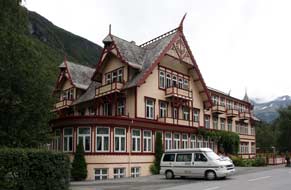 descent brought us down into the Hornindal valley to join the newly upgraded E39
Ålesund~Bergen road at the eastern tip of Lake Hornidalsvatnet. Eastwards over a
shoulder of higher ground, Route 15 dropped down to the inner reaches of Nordfjord which stretches way inland from the fretted west coast to the small
town of Stryn. We paused in this pleasant if unnoteworthy one-street town where
children with school bags indicated the start of the new school year; the
bustling main street was such a far cry from the peaceful, lonely wilds of Norangsdalen where we had been just an hour before. It was also noticeable that,
driving over from Langedalen, the birches were showing their firs hints of
autumn gold, another sign of the year moving on.
descent brought us down into the Hornindal valley to join the newly upgraded E39
Ålesund~Bergen road at the eastern tip of Lake Hornidalsvatnet. Eastwards over a
shoulder of higher ground, Route 15 dropped down to the inner reaches of Nordfjord which stretches way inland from the fretted west coast to the small
town of Stryn. We paused in this pleasant if unnoteworthy one-street town where
children with school bags indicated the start of the new school year; the
bustling main street was such a far cry from the peaceful, lonely wilds of Norangsdalen where we had been just an hour before. It was also noticeable that,
driving over from Langedalen, the birches were showing their firs hints of
autumn gold, another sign of the year moving on.
The glacier-fed lake of Strynevatnet:
leaving Stryn eastwards on Route 15, we followed the foaming white-waters of the
Strynelva river which flowed from glacier-fed Strynevatnet lake. Further up the
valley as we drove alongside the lake, its waters glowed with a beautiful soft
turquoise-blue colour derived from the glacial sediment brought down by the
waters flowing from the mighty Josterdalsbreen Glacier which spreads for some
480 square kms across the high mountains to the south. We paused at the
Josterdalsbreen National Park Centre, hoping to get information about the
glacier in readiness for our planned visit to one of the side-glaciers.
Regrettably however, the place was far more commercially oriented, geared to
selling souvenirs, plastic trolls and other such ephemeral rubbish rather than
providing serious information.
Grande Camping at the head of Lake Strynevatnet:
just beyond Oppstryn village, we reached tonight's campsite, the aptly named
Grande Camping at the head of Lake Strynevatnet. The few statics were all empty
on a wet mid-August Monday, and the separate camping area reserved for visitors
was set at the shore-side looking straight down the length of the turquoise-blue
lake. We had received a charmingly welcoming response from the owner to our
telephone enquiry inviting us to settle in; at this time of year, she would come
round in the evening to book us in. The price was a very reasonable 220 NOK/night
including showers and site-wide wi-fi internet, the facilities were first class
and spotlessly clean with well-appointed kitchen/wash-up and
washing/drying machine, and the setting was truly idyllic even in the gloomy
light of an overcast afternoon. We could not ask for more and gladly settled in.
The weather was still heavily overcast and late afternoon the wind increased
driving the lake's waters into waves washing up on the shingle shore-line below
us. From within the shelter of our camper, we watched White Wagtails busily pecking
along
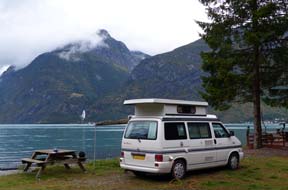 the water's edge as the wind-driven waves splashed at their little feet.
Both sides of the valley were enclosed by high, craggy mountains, to the south
topped by the Josterdalsbreen Glacier whose sediment-laden melt-waters flowed
down into Strynevatn giving it the cobalt-blue colour. On the northern side of
Strynedalen, a mighty waterfall cascaded down the mountain face dropping
vertically from the hanging valley of Glomnesdalen, formerly an area of transhumance
summer grazing. Once a side-valley of Strynedalen, Glomnesdalen was left
stranded as a hanging valley high above the main valley floor when Strynedalen
was more deeply eroded by glacial action during the Ice Age. The river which
flows along Glomnesdalen now cascades down this vertical drop to reach
Strynedalen lower valley floor at Glomnes. This was truly a magnificent spot to
camp with such a panorama set out before us, even though obscured by misty rain
cloud (Photo
44 - Grande Camping). That evening the lights from villages and hamlets along both sides of the
lake twinkled in the darkness, and after all the rain of the last 24 hours, the
waterfall dropping from Glomnesdalen could be heard roaring even in the distance in
the stillness of night. the water's edge as the wind-driven waves splashed at their little feet.
Both sides of the valley were enclosed by high, craggy mountains, to the south
topped by the Josterdalsbreen Glacier whose sediment-laden melt-waters flowed
down into Strynevatn giving it the cobalt-blue colour. On the northern side of
Strynedalen, a mighty waterfall cascaded down the mountain face dropping
vertically from the hanging valley of Glomnesdalen, formerly an area of transhumance
summer grazing. Once a side-valley of Strynedalen, Glomnesdalen was left
stranded as a hanging valley high above the main valley floor when Strynedalen
was more deeply eroded by glacial action during the Ice Age. The river which
flows along Glomnesdalen now cascades down this vertical drop to reach
Strynedalen lower valley floor at Glomnes. This was truly a magnificent spot to
camp with such a panorama set out before us, even though obscured by misty rain
cloud (Photo
44 - Grande Camping). That evening the lights from villages and hamlets along both sides of the
lake twinkled in the darkness, and after all the rain of the last 24 hours, the
waterfall dropping from Glomnesdalen could be heard roaring even in the distance in
the stillness of night.
Tomorrow we should move on over the mountains to Lom
and cross Northern Europe's highest mountain road-pass, the mighty Sognefjellveg
over the western Jotunheimen Mountains down to Sogndal, but that's for the next episode of our Norwegian travels. Join us
again shortly..
Next edition
to be published quite soon
|
Sheila and Paul |
Published: 18 February 2015 |
|
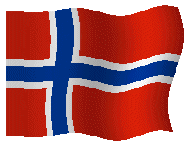
 CAMPING
IN NORWAY 2014 - Kristiansund, the Atlantic Road to Molde, Åndalsnes,
Raumabanen railway
to Dombås, Trollveggen rock face, Ålesund,
and into fjord-land to Hellesylt, Geirangerfjord, Stryn and
Strynevatn:
CAMPING
IN NORWAY 2014 - Kristiansund, the Atlantic Road to Molde, Åndalsnes,
Raumabanen railway
to Dombås, Trollveggen rock face, Ålesund,
and into fjord-land to Hellesylt, Geirangerfjord, Stryn and
Strynevatn: The Bergsøysund pontoon bridge:
we reached the first of the Krifast main bridges, the 933m (3,061 feet) long
Bergsøysund Bridge which connects the islands of Aspøya and Bergsøya in an
elegant sweeping curve (see left). The unique feature however of this magnificent structure
is that only its 2 ends are anchored into solid rock; the bridge's connecting
curvature is supported on 7 pontoons floating on the 320m deep, almost 1km wide Bergsøy Sound
(see below right). The significance of this pontoon structure was only apparent when
we parked in the lay-by and walked down to the flat fjord-side rocks. From this
vantage point, we had the perfect view looking
The Bergsøysund pontoon bridge:
we reached the first of the Krifast main bridges, the 933m (3,061 feet) long
Bergsøysund Bridge which connects the islands of Aspøya and Bergsøya in an
elegant sweeping curve (see left). The unique feature however of this magnificent structure
is that only its 2 ends are anchored into solid rock; the bridge's connecting
curvature is supported on 7 pontoons floating on the 320m deep, almost 1km wide Bergsøy Sound
(see below right). The significance of this pontoon structure was only apparent when
we parked in the lay-by and walked down to the flat fjord-side rocks. From this
vantage point, we had the perfect view looking around the bridge's full sweeping
curvature with its steel lattice-work supporting the road-decking floating on
its 7 huge pontoons in the fjord and spread at regular intervals around the
bridge's 933m width
(
around the bridge's full sweeping
curvature with its steel lattice-work supporting the road-decking floating on
its 7 huge pontoons in the fjord and spread at regular intervals around the
bridge's 933m width
( We pulled into a nearby parking area at the SW
tip of Bergsøya and walked down under the bridge's mighty piers; traffic passed
over the roadway high above with the noise of aircraft. This was such an
impressive spot from which to view the bridge's structure at close quarters; the
clusters of cable-stays anchored in concrete settings curved upwards towards the
bridges pylons. Being now toll-free, we could drive across the bridge without
charge, and began the long, steep climb under the first tower to the bridge's
lofty apex and down the far slope. Reaching the far shore, we turned off to a
small boat jetty for the panoramic view of the full sweep of this elegant
structure over a foreground of fishing boats
(see left) (
We pulled into a nearby parking area at the SW
tip of Bergsøya and walked down under the bridge's mighty piers; traffic passed
over the roadway high above with the noise of aircraft. This was such an
impressive spot from which to view the bridge's structure at close quarters; the
clusters of cable-stays anchored in concrete settings curved upwards towards the
bridges pylons. Being now toll-free, we could drive across the bridge without
charge, and began the long, steep climb under the first tower to the bridge's
lofty apex and down the far slope. Reaching the far shore, we turned off to a
small boat jetty for the panoramic view of the full sweep of this elegant
structure over a foreground of fishing boats
(see left) ( The Freifjord undersea tunnel:
re-crossing the suspension bridge, we now faced the 3rd of Krifast's major
structures, the 5.1km (3.2 miles) long Freifjord undersea tunnel, which passes
134m (440 feet) below the sea level of Freifjord Sound between the islands of Bergsøya
and Frei on Route 70's approach to Kristiansund (see right). The tunnel descends very
steeply for its first kilometre then levels out at its deepest point for 3kms
before rising steeply for its final kilometre to its exit on Frei island. The
1km ascent slopes at either end out of the tunnel's depths are both 3 lane
allowing overtaking of slow-moving traffic. It took 5 minutes to pass through
the undersea tunnel before we drove on across the width of Frei.
The Freifjord undersea tunnel:
re-crossing the suspension bridge, we now faced the 3rd of Krifast's major
structures, the 5.1km (3.2 miles) long Freifjord undersea tunnel, which passes
134m (440 feet) below the sea level of Freifjord Sound between the islands of Bergsøya
and Frei on Route 70's approach to Kristiansund (see right). The tunnel descends very
steeply for its first kilometre then levels out at its deepest point for 3kms
before rising steeply for its final kilometre to its exit on Frei island. The
1km ascent slopes at either end out of the tunnel's depths are both 3 lane
allowing overtaking of slow-moving traffic. It took 5 minutes to pass through
the undersea tunnel before we drove on across the width of Frei. Alanten Turistsenter-Camping at Kristiansund: the port-town of Kristiansund is spread across a complex
of 3 islands, Nordland, Gomaland and Innland, with its harbour set in the sound
between the islands. Crossing Nordland, we passed several of the town's marine
engineering works which now support Norway's off-shore oil and gas industry.
Although at this stage, Kristiansund's topography was totally bemusing, our sat-nav
guided us over to Gomaland island and around the town's northern side, eventually
reaching Alanten Turistsenter and Camping, our base for our stay in
Kristiansund. The girl at reception was smilingly welcoming and helpful,
providing a town-plan, explaining the walk into Kristiansund and its places of
interest, and pointing out the camping areas and facilities hut; the nightly
all-inclusive charge of 200 NOK seemed almost too good to be true, but more of
that later! We selected a pitch only to discover that power points were
non-functional, and eventually settled into another corner, hoping this would be
quiet and looking forward to a much-needed day in camp tomorrow (see left). The evening was
more dusky than ever with the sun setting soon after 10-00pm and not rising
until 5-00am.
Alanten Turistsenter-Camping at Kristiansund: the port-town of Kristiansund is spread across a complex
of 3 islands, Nordland, Gomaland and Innland, with its harbour set in the sound
between the islands. Crossing Nordland, we passed several of the town's marine
engineering works which now support Norway's off-shore oil and gas industry.
Although at this stage, Kristiansund's topography was totally bemusing, our sat-nav
guided us over to Gomaland island and around the town's northern side, eventually
reaching Alanten Turistsenter and Camping, our base for our stay in
Kristiansund. The girl at reception was smilingly welcoming and helpful,
providing a town-plan, explaining the walk into Kristiansund and its places of
interest, and pointing out the camping areas and facilities hut; the nightly
all-inclusive charge of 200 NOK seemed almost too good to be true, but more of
that later! We selected a pitch only to discover that power points were
non-functional, and eventually settled into another corner, hoping this would be
quiet and looking forward to a much-needed day in camp tomorrow (see left). The evening was
more dusky than ever with the sun setting soon after 10-00pm and not rising
until 5-00am. The following day we discovered the full scale
of Alanten Turistsenter and Camping's inadequacies, and the reason for its
apparently reasonable charge. The camping areas were careworn with inadequate or
unserviceable power supplies, and the facilities hopelessly limited: with just 2
WCs and showers for such a busy campsite, queues were inevitable; an apology for
a kitchen consisted of one outside wash-up sink and an electric ring, and
the wi-fi signal was too weak to reach the camping area. But the worst feature
was the abominable noise produced by the ventilation system which reverberated
around the entire camping area, making life intolerable for those camped nearby.
Our pitch around the corner escaped this noise but was not immune from the
overwhelmingly intrusive disturbance of
The following day we discovered the full scale
of Alanten Turistsenter and Camping's inadequacies, and the reason for its
apparently reasonable charge. The camping areas were careworn with inadequate or
unserviceable power supplies, and the facilities hopelessly limited: with just 2
WCs and showers for such a busy campsite, queues were inevitable; an apology for
a kitchen consisted of one outside wash-up sink and an electric ring, and
the wi-fi signal was too weak to reach the camping area. But the worst feature
was the abominable noise produced by the ventilation system which reverberated
around the entire camping area, making life intolerable for those camped nearby.
Our pitch around the corner escaped this noise but was not immune from the
overwhelmingly intrusive disturbance of
 excavating diggers. Only the pleasant
welcome given by the young receptionist prevented the place from getting the
first negative rating of the trip! We put up with the noise levels and made the
most of our day in camp.
excavating diggers. Only the pleasant
welcome given by the young receptionist prevented the place from getting the
first negative rating of the trip! We put up with the noise levels and made the
most of our day in camp.
 Back down into the city's main street Langveien we
visited the modern towered structure of the Kirkelandet church built in 1964 to
replace the town church flattened by WW2 German bombing (see left). The lines of the
church's plainly stark interior led the eye to the full height east-end stained glass
window
(
Back down into the city's main street Langveien we
visited the modern towered structure of the Kirkelandet church built in 1964 to
replace the town church flattened by WW2 German bombing (see left). The lines of the
church's plainly stark interior led the eye to the full height east-end stained glass
window
( was certainly impressive, more so
than Bodø's ascetic concrete barn of a cathedral. Outside, rose gardens
scented the air as we walked down the street towards the main square of Kongens
Plass for details of the Atlantic road from the helpful TIC. The main street
turned off to the modern bridge crossing to Innlandet island, but we continued
ahead down to the harbour where 2 huge oil rig construction or servicing ships
over-topped with cranes were moored in the sound. Following the
waterfront around, we reached the main pier of Piren with the Kristiansund's iconic statue
of Klippfiskkjerringa, the fish-wife carrying her basket of klippfisk,
recalling the days of these poor women's hard labours washing the fish in
the freezing shallows and laying it to dry on the harbour rocks (
was certainly impressive, more so
than Bodø's ascetic concrete barn of a cathedral. Outside, rose gardens
scented the air as we walked down the street towards the main square of Kongens
Plass for details of the Atlantic road from the helpful TIC. The main street
turned off to the modern bridge crossing to Innlandet island, but we continued
ahead down to the harbour where 2 huge oil rig construction or servicing ships
over-topped with cranes were moored in the sound. Following the
waterfront around, we reached the main pier of Piren with the Kristiansund's iconic statue
of Klippfiskkjerringa, the fish-wife carrying her basket of klippfisk,
recalling the days of these poor women's hard labours washing the fish in
the freezing shallows and laying it to dry on the harbour rocks ( Along the main waterfront
passing 2 typically
ostentatious Russian cruise boats moored there and the rusty hulk of another oil
rig servicing vessel, we reached the Hurtigruten quay, but this was all locked
up and deserted until the south-bound liner arrived at 4-30 this afternoon. Back
along
Along the main waterfront
passing 2 typically
ostentatious Russian cruise boats moored there and the rusty hulk of another oil
rig servicing vessel, we reached the Hurtigruten quay, but this was all locked
up and deserted until the south-bound liner arrived at 4-30 this afternoon. Back
along to Piren, we boarded the waiting Sundbåt to cross the harbour to
Gamle Byen on Innlandet. The honnør fare was 15 NOK and it took just a
couple of minutes to chug across the width of the harbour to the outer island,
and we spent a pleasant hour wandering around the lanes of the Old Town past all
the attractive and brightly coloured old wooden houses and cottages (
to Piren, we boarded the waiting Sundbåt to cross the harbour to
Gamle Byen on Innlandet. The honnør fare was 15 NOK and it took just a
couple of minutes to chug across the width of the harbour to the outer island,
and we spent a pleasant hour wandering around the lanes of the Old Town past all
the attractive and brightly coloured old wooden houses and cottages ( Back down the hill we boarded the 3-15pm Sundbåt
to cross firstly to the 3rd island of Nordlandet whose hillside was also lined
with attractive wooden houses, then on across the harbour to Gomalandet as the
coastal express ferry (Kystekspressen) from Trondheim arrived at the port.
The Sundbåt
Back down the hill we boarded the 3-15pm Sundbåt
to cross firstly to the 3rd island of Nordlandet whose hillside was also lined
with attractive wooden houses, then on across the harbour to Gomalandet as the
coastal express ferry (Kystekspressen) from Trondheim arrived at the port.
The Sundbåt dropped us at the quay-stop by the Klippfisk Museum, our next
stopping point. Housed in a venerable old wooden fish warehouse, the Milnbrygge,
named after the 1772 English merchant owner Walter Miln (
dropped us at the quay-stop by the Klippfisk Museum, our next
stopping point. Housed in a venerable old wooden fish warehouse, the Milnbrygge,
named after the 1772 English merchant owner Walter Miln ( renovated, the lane led around the eastern side of
the harbour to our starting point from this morning, and back up to the
campsite. Today had given us a fascinating insight into Kristiansund's long cod
fishing and klippfisk processing traditions which continue today, its wartime
destruction and German occupation, and its modern day renewal and prosperity as
a major port and servicing centre for Norway's North Sea oil and gas exploitation
(see below left). It was
a gritty, hard-working and attractive port-city; we liked it a lot.
renovated, the lane led around the eastern side of
the harbour to our starting point from this morning, and back up to the
campsite. Today had given us a fascinating insight into Kristiansund's long cod
fishing and klippfisk processing traditions which continue today, its wartime
destruction and German occupation, and its modern day renewal and prosperity as
a major port and servicing centre for Norway's North Sea oil and gas exploitation
(see below left). It was
a gritty, hard-working and attractive port-city; we liked it a lot. Byskogen Camping, Kristiansund: our original plan was to move
today, but rain had poured all night, and this morning the sky was dismally
overcast with rain cloud; it was still pouring. This certainly was not a day even
to contemplate the Atlantic Road, which tourist promotion describes as The
world's most beautiful drive. Given the forecast for continuing rain, the only
sensible thing was to sit it out in Kristiansund for another day and hope for
better weather tomorrow. We had chosen Alanten Turistsenter and Camping as a
base since it was within walking distance of the town, but with all the noise
disturbance and hopelessly inadequate, care-worn facilities, we decided to move
to Kristiansund's other campsite, Byskogen Camping over by the airfield. Having
re-stocked with provisions at a Co-op Extra hypermarket, we turned up to
Byskogen Camping. Set in a verdant grove surrounded by pine trees, the campsite
was deserted when we arrived. But the reception and service building were open
and facilities modern and clean with homely kitchen/common room and site-wide
wi-fi; we found a quiet corner of the camping area and settled in. The only
noise from the airfield was an occasional helicopter, rather more preferable
than the constant noise of diggers at Alanten Turistsenter! The weather remained overcast and the air
distinctly cooler, but the forecast was better for tomorrow when we should drive
the Atlantic Road around the spectacular west coast.
Byskogen Camping, Kristiansund: our original plan was to move
today, but rain had poured all night, and this morning the sky was dismally
overcast with rain cloud; it was still pouring. This certainly was not a day even
to contemplate the Atlantic Road, which tourist promotion describes as The
world's most beautiful drive. Given the forecast for continuing rain, the only
sensible thing was to sit it out in Kristiansund for another day and hope for
better weather tomorrow. We had chosen Alanten Turistsenter and Camping as a
base since it was within walking distance of the town, but with all the noise
disturbance and hopelessly inadequate, care-worn facilities, we decided to move
to Kristiansund's other campsite, Byskogen Camping over by the airfield. Having
re-stocked with provisions at a Co-op Extra hypermarket, we turned up to
Byskogen Camping. Set in a verdant grove surrounded by pine trees, the campsite
was deserted when we arrived. But the reception and service building were open
and facilities modern and clean with homely kitchen/common room and site-wide
wi-fi; we found a quiet corner of the camping area and settled in. The only
noise from the airfield was an occasional helicopter, rather more preferable
than the constant noise of diggers at Alanten Turistsenter! The weather remained overcast and the air
distinctly cooler, but the forecast was better for tomorrow when we should drive
the Atlantic Road around the spectacular west coast. The Atlantic Ocean Undersea Tunnel to Averøya: after a peaceful night at Byskogen, we woke to a
clear sky and sunny morning. The morning internal flight for Oslo was just taking off as
we departed to drive back through the northern outskirts of Kristiansund and
turn off onto Route 64 at the entrance to the Atlanterhavs-tunnelen (Atlantic
Ocean Tunnel). The 5.7km (3.5 miles) long tunnel connecting Kristiansund's
Kirkelandet island to Averøya runs beneath Bremsnesfjord reaching a depth of
250m below sea level, making it one of the world's deepest undersea tunnels.
Construction began in 2006, breaking through in March 2009; problems with
rock-falls, cave-ins and water leaks caused delays (although when you are
driving through, you prefer not to know this!) and consequent cost-overrun, and
the tunnel opened in December 2009. The 1km long descent and ascent at a
gradient of 10% have dual lanes for overtaking. 70% of the tunnel's 635 million
NOK construction cost is to be recovered from tolls which are still in operation
with an anticipated pay-back period of 18 years.
The Atlantic Ocean Undersea Tunnel to Averøya: after a peaceful night at Byskogen, we woke to a
clear sky and sunny morning. The morning internal flight for Oslo was just taking off as
we departed to drive back through the northern outskirts of Kristiansund and
turn off onto Route 64 at the entrance to the Atlanterhavs-tunnelen (Atlantic
Ocean Tunnel). The 5.7km (3.5 miles) long tunnel connecting Kristiansund's
Kirkelandet island to Averøya runs beneath Bremsnesfjord reaching a depth of
250m below sea level, making it one of the world's deepest undersea tunnels.
Construction began in 2006, breaking through in March 2009; problems with
rock-falls, cave-ins and water leaks caused delays (although when you are
driving through, you prefer not to know this!) and consequent cost-overrun, and
the tunnel opened in December 2009. The 1km long descent and ascent at a
gradient of 10% have dual lanes for overtaking. 70% of the tunnel's 635 million
NOK construction cost is to be recovered from tolls which are still in operation
with an anticipated pay-back period of 18 years. Kvernes stave church: we descended
into the tunnel at an alarming rate of fall and speed, thankful that Saturday
morning traffic was light; the re-ascent seemed even steeper. Emerging into
daylight at the toll-booths at the Averøya end, we faced a charge of 125 NOK (£12.50)
with no honnør reduction, our
contribution to the tunnel's construction cost recovery. We had also emerged
into an entirely different landscape from the Kristiansund islands: Averøya's knobbly, tree-covered fell-scape
looked delightful on a bright morning, especially against the exquisite blue of the Ocean away to our
right. A diversion brought us down to Bremnes quay from where the pre-tunnel
ferry had provided the only western road access to Kristiansund; today a sign warned
hopefuls that 'This ferry no longer operates' - so there! At the busy village of Bruhagen, we turned off from Route 64 onto the minor FV-247 lane which threaded
around the shore of Bremnesfjord down to the SE point of Averøya island and the
delightful farming village of Kvernes, where the ancient timber Kvernes
stave-church and its 19th century successor stood on the turf-lawned hill-side
looking out across the breadth of Kvernesfjord (see left).
Kvernes stave church: we descended
into the tunnel at an alarming rate of fall and speed, thankful that Saturday
morning traffic was light; the re-ascent seemed even steeper. Emerging into
daylight at the toll-booths at the Averøya end, we faced a charge of 125 NOK (£12.50)
with no honnør reduction, our
contribution to the tunnel's construction cost recovery. We had also emerged
into an entirely different landscape from the Kristiansund islands: Averøya's knobbly, tree-covered fell-scape
looked delightful on a bright morning, especially against the exquisite blue of the Ocean away to our
right. A diversion brought us down to Bremnes quay from where the pre-tunnel
ferry had provided the only western road access to Kristiansund; today a sign warned
hopefuls that 'This ferry no longer operates' - so there! At the busy village of Bruhagen, we turned off from Route 64 onto the minor FV-247 lane which threaded
around the shore of Bremnesfjord down to the SE point of Averøya island and the
delightful farming village of Kvernes, where the ancient timber Kvernes
stave-church and its 19th century successor stood on the turf-lawned hill-side
looking out across the breadth of Kvernesfjord (see left). The stav-kirke at Kvernes
was built around 1300 (
The stav-kirke at Kvernes
was built around 1300 ( baptistery added. In the following
decade, the then pastor, Rev Anders Erikson, at his own expense had the nave and
baptistery walls and ceiling decorated with acanthus leaf paintings (
baptistery added. In the following
decade, the then pastor, Rev Anders Erikson, at his own expense had the nave and
baptistery walls and ceiling decorated with acanthus leaf paintings ( The
Atlantic Road: along the southern shore of Averøya, we passed a
series of dairy farms with cattle grazing and silage being cut or already
stacked in bales ready for next winter. It was a lovely peaceful setting,
looking out across Kvernesfjord to the mountainous mainland coast opposite. The
lane re-joined Route 64 at Karvåg at the start of the spectacular 8 km long
Atlantic Road, built over an archipelago of islands and skerries across the
mouth of Lauvøyfjord, linked by causeways and a sequence of 8 bridges, the most
prominent being the high-arching, artistically curving Storseisundet Bridge (see
right). The
route was originally planned as a railway line in the early 20th century, but
this project was abandoned. Planning of a road route began in 1970 and
construction began in 1983. During the 6 year construction period, the area was
hit by 12 hurricanes along this wildly exposed stretch of the Atlantic
coastline. The road opened in July 1989 at a total cost of
The
Atlantic Road: along the southern shore of Averøya, we passed a
series of dairy farms with cattle grazing and silage being cut or already
stacked in bales ready for next winter. It was a lovely peaceful setting,
looking out across Kvernesfjord to the mountainous mainland coast opposite. The
lane re-joined Route 64 at Karvåg at the start of the spectacular 8 km long
Atlantic Road, built over an archipelago of islands and skerries across the
mouth of Lauvøyfjord, linked by causeways and a sequence of 8 bridges, the most
prominent being the high-arching, artistically curving Storseisundet Bridge (see
right). The
route was originally planned as a railway line in the early 20th century, but
this project was abandoned. Planning of a road route began in 1970 and
construction began in 1983. During the 6 year construction period, the area was
hit by 12 hurricanes along this wildly exposed stretch of the Atlantic
coastline. The road opened in July 1989 at a total cost of
 122 million NOK of
which 25% was to be financed by tolls, to be recovered over an expected 15 year
period. In fact, with greater than expected usage by both local and tourist
traffic, the debt had been paid off by 1999 when tolls ended. The Atlantic Road is now
designated as a
122 million NOK of
which 25% was to be financed by tolls, to be recovered over an expected 15 year
period. In fact, with greater than expected usage by both local and tourist
traffic, the debt had been paid off by 1999 when tolls ended. The Atlantic Road is now
designated as a  We began our crossing of steeply sloping,
curvature of Storseisundet Bridge, but as always the view from road level gave
little impression of the bridge's scale and artistic qualities. Across its
cantilevered 260m length onto Flatskjæret islet, we pulled into the next lay-by
and scrambled up onto the high point. This gave further views looking northwards
to Storseisundet Bridge, and to the south over the 3 interconnected sections of
Hulvågen Bridges which led 293m across onto Hulvågen island
(see above left) (
We began our crossing of steeply sloping,
curvature of Storseisundet Bridge, but as always the view from road level gave
little impression of the bridge's scale and artistic qualities. Across its
cantilevered 260m length onto Flatskjæret islet, we pulled into the next lay-by
and scrambled up onto the high point. This gave further views looking northwards
to Storseisundet Bridge, and to the south over the 3 interconnected sections of
Hulvågen Bridges which led 293m across onto Hulvågen island
(see above left) ( The fishing village of Bud and Bjølstad Camping: turning
off along a minor lane around Hustadvika Bay, the lane passed through farming
countryside, hamlets and the larger village of Farstad, winding its way around
the coast eventually to reach the large fishing village of Bud, where klippfisk
is still produced. We paused here and walked up to the preserved remains of a
huge WW2 German coastal battery on the headland looking down on Bud's fishing
harbour. Few boats seemed now to work from here, and these days tourism was
clearly the predominant industry.
Driving on along the coast through the small town of Elnesvågen, a
thoroughly unattractive place dominated by a huge chemical plant on the
fjord-side, we passed around the head of Malmefjord and turned off to tonight's
campsite, Bjølstad Camping. The place was sited on a steep hill-side sloping
down to the fjord with several terraced levels. We settled into the one
remaining space on a flatter level near to the service house. With its sloping
pitches, old-fashioned facilities, and worst of all noisy atmosphere, Bjølstad
Camping could at best only be described as mediocre, but would serve for an
overnight stop.
The fishing village of Bud and Bjølstad Camping: turning
off along a minor lane around Hustadvika Bay, the lane passed through farming
countryside, hamlets and the larger village of Farstad, winding its way around
the coast eventually to reach the large fishing village of Bud, where klippfisk
is still produced. We paused here and walked up to the preserved remains of a
huge WW2 German coastal battery on the headland looking down on Bud's fishing
harbour. Few boats seemed now to work from here, and these days tourism was
clearly the predominant industry.
Driving on along the coast through the small town of Elnesvågen, a
thoroughly unattractive place dominated by a huge chemical plant on the
fjord-side, we passed around the head of Malmefjord and turned off to tonight's
campsite, Bjølstad Camping. The place was sited on a steep hill-side sloping
down to the fjord with several terraced levels. We settled into the one
remaining space on a flatter level near to the service house. With its sloping
pitches, old-fashioned facilities, and worst of all noisy atmosphere, Bjølstad
Camping could at best only be described as mediocre, but would serve for an
overnight stop. Molde and the panoramic peak-land view from
Varden viewpoint: back to Route 64 the following morning, we turned
south avoiding a toll tunnel through high fell-land by taking the old road
around a side-valley, to approach the small port-town of Molde. We parked at the
fjord-side central square to enquire at the TIC about the route up onto the
Varden viewpoint above the town. Following our marked-up street plan steeply
uphill through a residential area, we reached the end of the tarmaced lane; a
gravelled road rose even more steeply up the hill-side eventually ending at a
café on the hill's summit. From here the view across the town, fjord and islands
was truly breath-taking with a panoramic skyline to the south said to encompass
222 peaks (
Molde and the panoramic peak-land view from
Varden viewpoint: back to Route 64 the following morning, we turned
south avoiding a toll tunnel through high fell-land by taking the old road
around a side-valley, to approach the small port-town of Molde. We parked at the
fjord-side central square to enquire at the TIC about the route up onto the
Varden viewpoint above the town. Following our marked-up street plan steeply
uphill through a residential area, we reached the end of the tarmaced lane; a
gravelled road rose even more steeply up the hill-side eventually ending at a
café on the hill's summit. From here the view across the town, fjord and islands
was truly breath-taking with a panoramic skyline to the south said to encompass
222 peaks ( Across Fannefjord
and Langefjord by tunnel, bridge and ferry: beginning the
steep descent into Molde's northern suburbs, we re-joined Route 64 south and
immediately entered the 2.7 km long undersea Fannefjord Tunnel which passes at a
depth of 101m below sea level across to Bolsøya Island in the centre of the
fjord. Completed in 1991 to replace a former ferry, and partially financed by
tolls, the debt was cleared in 14 years and the tunnel became toll-free in 2005.
At the far side of the island, the road curved gracefully over the high-arching
Bolsøy Bridge. Having crossed, we pulled in to view the sweeping bridge from the
fjord-side rocks, with a brisk wind driving breakers onto the shore making an
attractive foreground (see right). We now had a 12kms drive around the western end of the
beautiful Skåla peninsula in the bright afternoon sunshine to catch the next
ferry across Langefjord from Sølsnes to Åfarnes; we made it just in time to drive
straight aboard the ferry which pulled out as we stopped. Across on the far
side, Route 64 hugged the eastern shore of Rødvenfjord which was enclosed on
both sides by pine-forested green fells. In the bright afternoon sunshine with
blue sky reflected in the waters of the fjord, it was a glorious drive.
Across Fannefjord
and Langefjord by tunnel, bridge and ferry: beginning the
steep descent into Molde's northern suburbs, we re-joined Route 64 south and
immediately entered the 2.7 km long undersea Fannefjord Tunnel which passes at a
depth of 101m below sea level across to Bolsøya Island in the centre of the
fjord. Completed in 1991 to replace a former ferry, and partially financed by
tolls, the debt was cleared in 14 years and the tunnel became toll-free in 2005.
At the far side of the island, the road curved gracefully over the high-arching
Bolsøy Bridge. Having crossed, we pulled in to view the sweeping bridge from the
fjord-side rocks, with a brisk wind driving breakers onto the shore making an
attractive foreground (see right). We now had a 12kms drive around the western end of the
beautiful Skåla peninsula in the bright afternoon sunshine to catch the next
ferry across Langefjord from Sølsnes to Åfarnes; we made it just in time to drive
straight aboard the ferry which pulled out as we stopped. Across on the far
side, Route 64 hugged the eastern shore of Rødvenfjord which was enclosed on
both sides by pine-forested green fells. In the bright afternoon sunshine with
blue sky reflected in the waters of the fjord, it was a glorious drive. Rødven stave church: reaching the head of the fjord, we turned off onto
a narrow lane shelving above the fjord's western shore-line. After 10kms through
dairy farming country, we reached the scattered hamlet of Rødven and down by the
fjord we found the tiny wooden Rødven stave-church (
Rødven stave church: reaching the head of the fjord, we turned off onto
a narrow lane shelving above the fjord's western shore-line. After 10kms through
dairy farming country, we reached the scattered hamlet of Rødven and down by the
fjord we found the tiny wooden Rødven stave-church ( such cruise ships
regularly befoul Isfjord, overwhelming the tiny
port of Åndalsnes with massed tourists most days of the year. We rounded the head of the inlet at the village of Isfjord and, in heavy
traffic, returned along the south shore into Åndalsnes, eventually finding the
TIC down by the railway station at the terminus of the Raumabanen railway line.
The TIC had closed at 4-00pm but the ticket office was still open for us to
enquire about train times and ticket prices for our planned excursion on the
spectacular line up to Dombås.
such cruise ships
regularly befoul Isfjord, overwhelming the tiny
port of Åndalsnes with massed tourists most days of the year. We rounded the head of the inlet at the village of Isfjord and, in heavy
traffic, returned along the south shore into Åndalsnes, eventually finding the
TIC down by the railway station at the terminus of the Raumabanen railway line.
The TIC had closed at 4-00pm but the ticket office was still open for us to
enquire about train times and ticket prices for our planned excursion on the
spectacular line up to Dombås. range and the
conical peak of Romsdalshornet (
range and the
conical peak of Romsdalshornet ( right).
right). The Kylling Bridge: gaining much
height, the road reached the hamlet of Verma and just beyond the turning up to
Verma Station, we turned into a parking area by a shop-cum-café near to where
the railway line crosses the river gorge on the high-arching Kylling Bridge. A
footpath was signed to a lookout-point high above the river-gorge looking across
to the stone railway bridge. From the timetable, we could see that the afternoon
down train left Bjorli station some 10 minutes south of here at 2-44pm. With the
weather still gloomily overcast, we
The Kylling Bridge: gaining much
height, the road reached the hamlet of Verma and just beyond the turning up to
Verma Station, we turned into a parking area by a shop-cum-café near to where
the railway line crosses the river gorge on the high-arching Kylling Bridge. A
footpath was signed to a lookout-point high above the river-gorge looking across
to the stone railway bridge. From the timetable, we could see that the afternoon
down train left Bjorli station some 10 minutes south of here at 2-44pm. With the
weather still gloomily overcast, we followed the footpath steeply down into
woods to reach a superbly positioned viewing point directly opposite the Kylling
Bridge. This magnificently iconic 76m (249 feet) long bridge, its main stone
arch having a span of 42m (138 feet), rose 59m (194 feet) above the river gorge
and waterfalls way down below (see left). Set among pine woods, this was a truly
magnificent setting; all we needed now was the red railcar of the Raumabanen
train to cross.
followed the footpath steeply down into
woods to reach a superbly positioned viewing point directly opposite the Kylling
Bridge. This magnificently iconic 76m (249 feet) long bridge, its main stone
arch having a span of 42m (138 feet), rose 59m (194 feet) above the river gorge
and waterfalls way down below (see left). Set among pine woods, this was a truly
magnificent setting; all we needed now was the red railcar of the Raumabanen
train to cross. Verma Station and the 180º
curving Stavem Tunnel:
after crossing the Kylling Bridge, the railway line enters the 480m long Kylling
Tunnel, curving around through 90º on a gradient to gain further height up to
Verma Station. We walked
back along the road and climbed steeply up a side lane towards the
station with the line high above us. Two monuments stood beside the station: one
was a memorial to the 7 men who were killed during the Raumabanen line's 1912~24
construction; the other memorial bearing the royal coast of arms and Håkon VII's
monogram celebrated the line's official opening on 29 November 1924 (see left). The small
wooden station building by the trackside and passing loop bore the plaque:
Verma 273m høgd over havet (elevation above sea level) - 418,09km Oslo - 39.19 Åndalsnes.
Beyond the station the line curved away northwards towards Stavem
Verma Station and the 180º
curving Stavem Tunnel:
after crossing the Kylling Bridge, the railway line enters the 480m long Kylling
Tunnel, curving around through 90º on a gradient to gain further height up to
Verma Station. We walked
back along the road and climbed steeply up a side lane towards the
station with the line high above us. Two monuments stood beside the station: one
was a memorial to the 7 men who were killed during the Raumabanen line's 1912~24
construction; the other memorial bearing the royal coast of arms and Håkon VII's
monogram celebrated the line's official opening on 29 November 1924 (see left). The small
wooden station building by the trackside and passing loop bore the plaque:
Verma 273m høgd over havet (elevation above sea level) - 418,09km Oslo - 39.19 Åndalsnes.
Beyond the station the line curved away northwards towards Stavem Tunnel, more of which later
(see right). The Raumabanen line was truly staggering piece of civil engineering
construction to drive a railway line through such impossibly inhospitable terrain.
Tunnel, more of which later
(see right). The Raumabanen line was truly staggering piece of civil engineering
construction to drive a railway line through such impossibly inhospitable terrain. The rock faces of Trollveggen:
with a brighter sun now lighting the mountain sides, we drove down from the
upper valley back into the spectacular middle section of Romsdalen where the
mountain walls closed in to create a narrow canyon. On both sides of the road
sheer rock walls towered overhead, those rearing upwards on the eastern side now
fully lit by the afternoon sun. Further down valley however it was the
unbelievable towering rock walls of Trollveggen that really commanded attention.
The ice-smoothed gnarled buttresses rose immediately overhead ominously
threatening in dark shade, then rounding a another bend, sun caught the mountain
side highlighting details on this mighty rock face. It was a truly awe-inspiring
sight (see left).
The rock faces of Trollveggen:
with a brighter sun now lighting the mountain sides, we drove down from the
upper valley back into the spectacular middle section of Romsdalen where the
mountain walls closed in to create a narrow canyon. On both sides of the road
sheer rock walls towered overhead, those rearing upwards on the eastern side now
fully lit by the afternoon sun. Further down valley however it was the
unbelievable towering rock walls of Trollveggen that really commanded attention.
The ice-smoothed gnarled buttresses rose immediately overhead ominously
threatening in dark shade, then rounding a another bend, sun caught the mountain
side highlighting details on this mighty rock face. It was a truly awe-inspiring
sight (see left). two return
fares almost £100! But she suggested a cheaper option: honnør reduced-price regular return tickets for Otta beyond Dombås cost only 316 NOK each; we need
only travel as far as Dombås before catching the return train. Such helpful
advice was much appreciated by us even if not by her employer, the Norwegian
State Railways!
two return
fares almost £100! But she suggested a cheaper option: honnør reduced-price regular return tickets for Otta beyond Dombås cost only 316 NOK each; we need
only travel as far as Dombås before catching the return train. Such helpful
advice was much appreciated by us even if not by her employer, the Norwegian
State Railways!  Following plans for the Oslo~Trondheim railway
line over Dovrefjell, there was pressure from the coastal municipalities for a
branch line out to the west coast, with intense rivalry between Kristiansund,
Molde and Ålesund as the proposed destination of the line's extension and the
route it would take. By 1910 the National Railway Board proposed a branch line
from Dombås down Romsdalen to Åndalsnes, the Rauma Line, and in 1912 the
Storting gave approval for the line to be built, with the long term aim of
extending it onwards to one of the west coast towns. Construction began in 1912
with navvies working on 4 geographical sections of the route and its
infrastructure. The line was opened in 3 stages: the initial 57kms from Dombås
to Bjorli in late 1921, the next 18kms from Bjorli to Verma in 1923, and the
whole line received its royal opening on 29 November 1924 with regular services
Following plans for the Oslo~Trondheim railway
line over Dovrefjell, there was pressure from the coastal municipalities for a
branch line out to the west coast, with intense rivalry between Kristiansund,
Molde and Ålesund as the proposed destination of the line's extension and the
route it would take. By 1910 the National Railway Board proposed a branch line
from Dombås down Romsdalen to Åndalsnes, the Rauma Line, and in 1912 the
Storting gave approval for the line to be built, with the long term aim of
extending it onwards to one of the west coast towns. Construction began in 1912
with navvies working on 4 geographical sections of the route and its
infrastructure. The line was opened in 3 stages: the initial 57kms from Dombås
to Bjorli in late 1921, the next 18kms from Bjorli to Verma in 1923, and the
whole line received its royal opening on 29 November 1924 with regular services starting the following day. The Rauma Line over its 114km length from Dombås,
the line's highest point at 659m above sea level, down to Åndalsnes on the
coastal fjord at 4m above sea level, entails a drop in elevation of 655m. The
nature of the terrain, and achievement of gradients capable of being tackled by
steam locomotives of the day, meant severe challenges for construction engineers.
The line required a total of 103 bridges and 5 tunnels, but it was not just the
problem of spanning gorges with bridges. The greatest challenge was raising the
route up the 655m elevation gain on a satisfactory gradient in upper Romsdalen
(see right). This was achieved by the boldly conceived Stavem
Tunnel, which along its 1,396m length turns through a full 180º on a horseshoe
loop, to emerge further south in the opposite direction with a 19m gain in
elevation from 313m above sea level at its line of entry at the northern end of the tunnel
to 332m at its exit point. The tunnel
took 9 years of hard manual labour to construct and was bored from both ends;
given the 180º curvature and 3 dimensional raising of height, this was an
unbelievable piece of civil engineering (see map above left). But so precise was the surveying that
when the 2 ends joined up, the vertical and horizontal differences were a mere
3.5 cms out! For details of the Raumabanen, see the
starting the following day. The Rauma Line over its 114km length from Dombås,
the line's highest point at 659m above sea level, down to Åndalsnes on the
coastal fjord at 4m above sea level, entails a drop in elevation of 655m. The
nature of the terrain, and achievement of gradients capable of being tackled by
steam locomotives of the day, meant severe challenges for construction engineers.
The line required a total of 103 bridges and 5 tunnels, but it was not just the
problem of spanning gorges with bridges. The greatest challenge was raising the
route up the 655m elevation gain on a satisfactory gradient in upper Romsdalen
(see right). This was achieved by the boldly conceived Stavem
Tunnel, which along its 1,396m length turns through a full 180º on a horseshoe
loop, to emerge further south in the opposite direction with a 19m gain in
elevation from 313m above sea level at its line of entry at the northern end of the tunnel
to 332m at its exit point. The tunnel
took 9 years of hard manual labour to construct and was bored from both ends;
given the 180º curvature and 3 dimensional raising of height, this was an
unbelievable piece of civil engineering (see map above left). But so precise was the surveying that
when the 2 ends joined up, the vertical and horizontal differences were a mere
3.5 cms out! For details of the Raumabanen, see the  further km, the line
entered Stavem Tunnel, but from the train there was little sense of the line's
full 180º curve. It was only when the train emerged at the tunnel's southern end
that we could see the line faced in the opposite direction from entering the
tunnel; not only that but the approach line could be seen way down below at the
level of Verma Station. Even more startling however, the upward line on the far
side of the river gorge back from Kylling bridge which now came into view was
even lower, a clear revelation of just how much height gain the line had to
achieve at a reasonable climbing gradient in such a short distance (see above
right). Travelling now across high plateau fell-land, the train soon reached its
first stop at Bjorli Station, a scattered mountain village and winter sports
centre. The line now followed and crossed the Romsdals River which ran
vigorously along rocky gorges, until it reached the 11km long Lesjaskogvatnet
set on the watershed plateau with outflow rivers at both the eastern and western
ends. A short distance further and the train pulled into Dombås (
further km, the line
entered Stavem Tunnel, but from the train there was little sense of the line's
full 180º curve. It was only when the train emerged at the tunnel's southern end
that we could see the line faced in the opposite direction from entering the
tunnel; not only that but the approach line could be seen way down below at the
level of Verma Station. Even more startling however, the upward line on the far
side of the river gorge back from Kylling bridge which now came into view was
even lower, a clear revelation of just how much height gain the line had to
achieve at a reasonable climbing gradient in such a short distance (see above
right). Travelling now across high plateau fell-land, the train soon reached its
first stop at Bjorli Station, a scattered mountain village and winter sports
centre. The line now followed and crossed the Romsdals River which ran
vigorously along rocky gorges, until it reached the 11km long Lesjaskogvatnet
set on the watershed plateau with outflow rivers at both the eastern and western
ends. A short distance further and the train pulled into Dombås ( As was forecast, the weather up here at Dombås
659m above fjord-level was overcast and distinctly cooler. North of the station platforms, the 2
lines each disappeared into their separate tunnels, the main Trondheim line
NE-wards across Dovrefjell and the Raumabanen NW down to Åndalsnes. The main
line train from Trondheim onward to Oslo, which we should have changed to had we
used our tickets on to Otta, pulled in shortly. We now had just over an hour to
wait at Dombås before the Raumabanen train returned to Åndalsnes. Looking around
towards the town across the hillside, nothing seemed familiar from our visit to Dombås
on our northward journey which now seemed so long ago earlier in the trip. The
Oslo~Trondheim return train, which we should have caught back from Otta, in fact
was running over an hour late. Since it connected with the Raumabanen train, we
now had a further wait for our return to Åndalsnes. The Oslo train eventually
arrived, passengers transferred, and our train pulled out to return down into Romsdalen. We spent the journey through this magnificent scenery admiring the
skill of the railway engineers, and on the downward run there was a distinct
feeling of the Stavem Tunnel's 180º curve as the train rounded the horseshoe in
the tunnel's darkness. The other noticeable factor, looking out across the gorge
just after crossing the Kylling Bridge, was the markedly higher line descending
from the Stavem Tunnel's lower portal and perched high on the sheer face of the
mountainside. It was a truly remarkable engineering feat to have driven a
railway line on a rising gradient across what appeared the vertical face of the
mountain. Down through the middle~lower valley, through the narrowing canyon
enclosed by Trollveggen on the western side and Romdalshornet on the east,
the train returned to Åndalsnes, now in bright sunshine. The port area by the
station was awash with tourists from the cruise ship with nothing better to do
than to take snaps of one another by the fjord-side troll statue.
As was forecast, the weather up here at Dombås
659m above fjord-level was overcast and distinctly cooler. North of the station platforms, the 2
lines each disappeared into their separate tunnels, the main Trondheim line
NE-wards across Dovrefjell and the Raumabanen NW down to Åndalsnes. The main
line train from Trondheim onward to Oslo, which we should have changed to had we
used our tickets on to Otta, pulled in shortly. We now had just over an hour to
wait at Dombås before the Raumabanen train returned to Åndalsnes. Looking around
towards the town across the hillside, nothing seemed familiar from our visit to Dombås
on our northward journey which now seemed so long ago earlier in the trip. The
Oslo~Trondheim return train, which we should have caught back from Otta, in fact
was running over an hour late. Since it connected with the Raumabanen train, we
now had a further wait for our return to Åndalsnes. The Oslo train eventually
arrived, passengers transferred, and our train pulled out to return down into Romsdalen. We spent the journey through this magnificent scenery admiring the
skill of the railway engineers, and on the downward run there was a distinct
feeling of the Stavem Tunnel's 180º curve as the train rounded the horseshoe in
the tunnel's darkness. The other noticeable factor, looking out across the gorge
just after crossing the Kylling Bridge, was the markedly higher line descending
from the Stavem Tunnel's lower portal and perched high on the sheer face of the
mountainside. It was a truly remarkable engineering feat to have driven a
railway line on a rising gradient across what appeared the vertical face of the
mountain. Down through the middle~lower valley, through the narrowing canyon
enclosed by Trollveggen on the western side and Romdalshornet on the east,
the train returned to Åndalsnes, now in bright sunshine. The port area by the
station was awash with tourists from the cruise ship with nothing better to do
than to take snaps of one another by the fjord-side troll statue. Trollveggen Camping set at the foot of the Trollveggen rock wall: thankfully we returned
to the peace of Romsdalen for our final night in the valley at Trollveggen
Camping. The camping area was pleasantly laid out with peaceful, grassy pitches
among the trees alongside the fast-flowing Rauma River. But the most stunningly
spectacular feature was the setting, immediately at the foot of the 1000m high
rock wall and crenulated crested ridge-line of Trollveggen. Contrary to our
fears, there was plenty of space, and we selected a peaceful pitch in the
furthest corner giving the clearest view looking directly up at Europe's
greatest rock wall (see left). Before settling in we drove further up valley to the Trollveggen Visitor Centre. This however was another world away from the wild
nature it claimed to represent: an unrestrained mecca of mass tourism, sordidly rampant and over-commercialised materialistic greed. The car park was
filled by a whole fleet of tour-buses ferrying the occupants of the ghastly
cruise ship which overwhelmed Åndalsnes' little port. The so-called Visitor
Centre was nothing more than an over-sized gift shop where mindless souls milled
around looking for trolls and aimlessly spending their money on the basest of
ephemeral trash. The only worthwhile feature of the place was the film show with
archive footing on the history of climbing and parachute jumping on Trollveggen's rock wall. Unsure which was worse, the unrestrained commercialism
or the flocks of brainless clientele milling around, we got out as fast as we
could and returned to the peaceful sanctuary of Trollveggen Camping (
Trollveggen Camping set at the foot of the Trollveggen rock wall: thankfully we returned
to the peace of Romsdalen for our final night in the valley at Trollveggen
Camping. The camping area was pleasantly laid out with peaceful, grassy pitches
among the trees alongside the fast-flowing Rauma River. But the most stunningly
spectacular feature was the setting, immediately at the foot of the 1000m high
rock wall and crenulated crested ridge-line of Trollveggen. Contrary to our
fears, there was plenty of space, and we selected a peaceful pitch in the
furthest corner giving the clearest view looking directly up at Europe's
greatest rock wall (see left). Before settling in we drove further up valley to the Trollveggen Visitor Centre. This however was another world away from the wild
nature it claimed to represent: an unrestrained mecca of mass tourism, sordidly rampant and over-commercialised materialistic greed. The car park was
filled by a whole fleet of tour-buses ferrying the occupants of the ghastly
cruise ship which overwhelmed Åndalsnes' little port. The so-called Visitor
Centre was nothing more than an over-sized gift shop where mindless souls milled
around looking for trolls and aimlessly spending their money on the basest of
ephemeral trash. The only worthwhile feature of the place was the film show with
archive footing on the history of climbing and parachute jumping on Trollveggen's rock wall. Unsure which was worse, the unrestrained commercialism
or the flocks of brainless clientele milling around, we got out as fast as we
could and returned to the peaceful sanctuary of Trollveggen Camping (
 It is impossible to convey in words the
full scale and impact of this unbelievable mountain wall. Suffice to say that,
with this uninterrupted view of Trollveggen's line of cliffs, this was one of
the most memorable spots we had ever camped at.
It is impossible to convey in words the
full scale and impact of this unbelievable mountain wall. Suffice to say that,
with this uninterrupted view of Trollveggen's line of cliffs, this was one of
the most memorable spots we had ever camped at. Westwards to Ålesund: back down-valley to Åndalsnes, we turned off westwards on
E136 through tunnels, around the Innfjord inlet and the main body of
Romsdalsfjord, over to the long inlet of Trestfjord. A new bridge being
constructed across the width of Trestfjord was incomplete, meaning a long drive
around the head of the fjord. Partway along the western shore, E136 joined E39
coming in from Molde to gain height over high fell-land and a long descent on
the western slopes down Landedalen to the small town of Sjøholt. The road
continued westwards along a narrow isthmus leading to the long crab's
claw-shaped narrow peninsula with Ålesund perched at its NW extremity. Reaching
the town of Spjelkavik, we faced a confusingly complex series of road junctions
and the busiest and most stressful traffic encountered in the whole of Norway.
Thankful for the sat-nav's reassuring guidance, we worked our way through
westwards eventually to approach Ålesund, to turn off into Volsdalen
Camping. Being a small campsite, there was little space, but we found not so
much a pitch but a gravelled parking area; the owner however welcomed us with
helpful hospitality even offering a discount for our camping card (unprecedented
in Norway!).
Westwards to Ålesund: back down-valley to Åndalsnes, we turned off westwards on
E136 through tunnels, around the Innfjord inlet and the main body of
Romsdalsfjord, over to the long inlet of Trestfjord. A new bridge being
constructed across the width of Trestfjord was incomplete, meaning a long drive
around the head of the fjord. Partway along the western shore, E136 joined E39
coming in from Molde to gain height over high fell-land and a long descent on
the western slopes down Landedalen to the small town of Sjøholt. The road
continued westwards along a narrow isthmus leading to the long crab's
claw-shaped narrow peninsula with Ålesund perched at its NW extremity. Reaching
the town of Spjelkavik, we faced a confusingly complex series of road junctions
and the busiest and most stressful traffic encountered in the whole of Norway.
Thankful for the sat-nav's reassuring guidance, we worked our way through
westwards eventually to approach Ålesund, to turn off into Volsdalen
Camping. Being a small campsite, there was little space, but we found not so
much a pitch but a gravelled parking area; the owner however welcomed us with
helpful hospitality even offering a discount for our camping card (unprecedented
in Norway!). Ålesund and its Jugenstil architecture: the fishing and ferry port of Ålesund
has a distinctly different appearance from other Norwegian towns, as a result of
a devastating fire which destroyed the wooden buildings of the entire central
part of the town in 1904, leaving 10,000 of its 12,000 inhabitants homeless. A
reconstruction programme got underway immediately with emergency assistance and
shiploads of building materials and foodstuffs sent from Germany by Kaiser
Wilhelm II. At a time of economic depression and high unemployment in Norway,
craftsmen and labourers arrived from all over the country in the hope of finding
work. Young, nationalistically-minded Norwegian architects, trained mainly in
Germany, redesigned the new town in the characteristic Jugenstil style popular at
the time, but adding Nordic themes. The result was that Ålesund acquired the
distinctive art nouveau appearance seen today along the streets of the
central area around the port (
Ålesund and its Jugenstil architecture: the fishing and ferry port of Ålesund
has a distinctly different appearance from other Norwegian towns, as a result of
a devastating fire which destroyed the wooden buildings of the entire central
part of the town in 1904, leaving 10,000 of its 12,000 inhabitants homeless. A
reconstruction programme got underway immediately with emergency assistance and
shiploads of building materials and foodstuffs sent from Germany by Kaiser
Wilhelm II. At a time of economic depression and high unemployment in Norway,
craftsmen and labourers arrived from all over the country in the hope of finding
work. Young, nationalistically-minded Norwegian architects, trained mainly in
Germany, redesigned the new town in the characteristic Jugenstil style popular at
the time, but adding Nordic themes. The result was that Ålesund acquired the
distinctive art nouveau appearance seen today along the streets of the
central area around the port ( Given that it was only 3-00pm, we decided to walk
into the centre for a preliminary visit to Ålesund this afternoon. The campsite
owner provided us with a town booklet and directions, assuring us it was only a
1.5km walk. Beyond the sports stadium, a footbridge led over the busy E136,
through a residential area with some wooden cottages which must have survived
the fire, and into the centre. Ålesund is crammed onto the narrowest part of the
westward-facing peninsula which rises steeply along its central spine. The
central streets therefore rise steeply up from the port with a stepped path
leading to a viewpoint atop the hill. Reaching the centre, we followed Kaiser
Wilhelm gata, named after the town's benefactor, and up Storgata to find 2 of
the characteristically Jugenstil streets, Løvenvoldgata and Kongensgata; but
apart from a couple of buildings
Given that it was only 3-00pm, we decided to walk
into the centre for a preliminary visit to Ålesund this afternoon. The campsite
owner provided us with a town booklet and directions, assuring us it was only a
1.5km walk. Beyond the sports stadium, a footbridge led over the busy E136,
through a residential area with some wooden cottages which must have survived
the fire, and into the centre. Ålesund is crammed onto the narrowest part of the
westward-facing peninsula which rises steeply along its central spine. The
central streets therefore rise steeply up from the port with a stepped path
leading to a viewpoint atop the hill. Reaching the centre, we followed Kaiser
Wilhelm gata, named after the town's benefactor, and up Storgata to find 2 of
the characteristically Jugenstil streets, Løvenvoldgata and Kongensgata; but
apart from a couple of buildings
 with decorative floral motifs
(see right) (
with decorative floral motifs
(see right) ( the whole trip, a
singularly unattractive place filled with ill-mannered, rowdy folk showing no
neighbourly consideration for others. The facilities were modern with
well-intentioned, integrated bathroom design, but simply insufficient meaning
queues. Having said that, the owner was helpful and
welcoming. So underwhelmed
were we yesterday afternoon by Ålesund's over-promoted but unexceptional
Jugenstil architecture and its overcrowding with
the whole trip, a
singularly unattractive place filled with ill-mannered, rowdy folk showing no
neighbourly consideration for others. The facilities were modern with
well-intentioned, integrated bathroom design, but simply insufficient meaning
queues. Having said that, the owner was helpful and
welcoming. So underwhelmed
were we yesterday afternoon by Ålesund's over-promoted but unexceptional
Jugenstil architecture and its overcrowding with
 traffic and tourists, we were
tempted to give today's visit a miss and move on. But having discovered the
buses that ran regularly from the nearby shops into the centre, we gave Ålesund
a second chance. The 5 minute bus ride dropped us at Kaiser Bill Street by the
bus station, and we began a circular walk around the central area best known for
its Jugenstil architecture.
traffic and tourists, we were
tempted to give today's visit a miss and move on. But having discovered the
buses that ran regularly from the nearby shops into the centre, we gave Ålesund
a second chance. The 5 minute bus ride dropped us at Kaiser Bill Street by the
bus station, and we began a circular walk around the central area best known for
its Jugenstil architecture.
 harbour with the high spine of the Ålesund peninsula
rising beyond (
harbour with the high spine of the Ålesund peninsula
rising beyond ( along the fjord-side is apparently
a major centre of furniture manufacturing, including the factory making the
designer Stressless Chairs, not that we had ever heard of these; their web site
shows illustrations, all looking like ... well chairs! Appropriately Sykkylven
houses the Norwegian Furniture Museum. In the town's southern outskirts we
reached tonight's campsite Sjøbakken Camping. There were 2 small camping areas
terraced into the hillside overlooking the fjord, and the owner came over to
welcome us, telling us about the town and the fjord's fishing potential. The
rain had eased but on such a gloomy evening not only did dusk settle early, but
full darkness; long gone were the light evenings this far south at 62ºN,
and that evening we even had the heater on.
along the fjord-side is apparently
a major centre of furniture manufacturing, including the factory making the
designer Stressless Chairs, not that we had ever heard of these; their web site
shows illustrations, all looking like ... well chairs! Appropriately Sykkylven
houses the Norwegian Furniture Museum. In the town's southern outskirts we
reached tonight's campsite Sjøbakken Camping. There were 2 small camping areas
terraced into the hillside overlooking the fjord, and the owner came over to
welcome us, telling us about the town and the fjord's fishing potential. The
rain had eased but on such a gloomy evening not only did dusk settle early, but
full darkness; long gone were the light evenings this far south at 62ºN,
and that evening we even had the heater on. South to Hellesylt and Geirangerfjord:
the weather forecast for the next few days, when we were heading for what was
scenically some of the most attractive parts of fjord-land, was far from good;
much rain was forecast. Route 60 headed south from Sykkylven past the end of the
fjord gaining height steeply in tight sweeping curves up Velledalen. Once beyond
the watershed, the road began a long, equally steep descent into a narrow valley
to Stranda where we shopped for the coming weekend. With the weather still
gloomily overcast, Route 60 climbed steadily up the alpine farming valley of
Strandadalen. Ahead the dark mountainous massif seemed to present an impassable
barrier to further progress, but the road soon entered a 3km long tunnel,
unnervingly narrow and poorly lit,. We were thankful to emerge into daylight at
the far end, and pulled over into a lay-by on the outer side of the road for the
bird's eye view looking down across the steep-sided Sunnylvsfjord, the
innermost extension of the mighty Storfjord. The dull weather made what would
otherwise have been a stunning view disappointingly murky. A little further a
newly built viewpoint gave even better views looking directly into the mouth of
the renowned Geirangerfjord which branches off westwards enclosed by sheer,
vertical-sided mountain walls. Again poor light marred what would have been a
perfect photographic vantage point (see left). The Geirangerfjord ferry was just
South to Hellesylt and Geirangerfjord:
the weather forecast for the next few days, when we were heading for what was
scenically some of the most attractive parts of fjord-land, was far from good;
much rain was forecast. Route 60 headed south from Sykkylven past the end of the
fjord gaining height steeply in tight sweeping curves up Velledalen. Once beyond
the watershed, the road began a long, equally steep descent into a narrow valley
to Stranda where we shopped for the coming weekend. With the weather still
gloomily overcast, Route 60 climbed steadily up the alpine farming valley of
Strandadalen. Ahead the dark mountainous massif seemed to present an impassable
barrier to further progress, but the road soon entered a 3km long tunnel,
unnervingly narrow and poorly lit,. We were thankful to emerge into daylight at
the far end, and pulled over into a lay-by on the outer side of the road for the
bird's eye view looking down across the steep-sided Sunnylvsfjord, the
innermost extension of the mighty Storfjord. The dull weather made what would
otherwise have been a stunning view disappointingly murky. A little further a
newly built viewpoint gave even better views looking directly into the mouth of
the renowned Geirangerfjord which branches off westwards enclosed by sheer,
vertical-sided mountain walls. Again poor light marred what would have been a
perfect photographic vantage point (see left). The Geirangerfjord ferry was just beginning
its passage along this spectacularly narrow fjord, and just as we were leaving
the Hurtigrute liner moved slowly below us on its excursion into Storfjord and
Geirangerfjord (
beginning
its passage along this spectacularly narrow fjord, and just as we were leaving
the Hurtigrute liner moved slowly below us on its excursion into Storfjord and
Geirangerfjord ( Stadheimfossen Camping:
a couple of kms along the valley from Hellesylt, we reached tonight's campsite,
Stadheimfossen Camping; even on an overcast day, this tiny campsite looked instantly appealing, set
alongside its noisily rushing river and eponymous waterfalls (see left). The owner welcomed
us with a laid-back greeting, pointing out the camping area: settle yourselves
in and I'll be back later to sort out the paper-work, he said. We camped in a
corner by the river, with the roar of the waterfalls filling the air. The
facilities were reasonable and the nightly charge a good value 215 NOK; this was
a charmingly peaceful and welcoming spot to camp.
Stadheimfossen Camping:
a couple of kms along the valley from Hellesylt, we reached tonight's campsite,
Stadheimfossen Camping; even on an overcast day, this tiny campsite looked instantly appealing, set
alongside its noisily rushing river and eponymous waterfalls (see left). The owner welcomed
us with a laid-back greeting, pointing out the camping area: settle yourselves
in and I'll be back later to sort out the paper-work, he said. We camped in a
corner by the river, with the roar of the waterfalls filling the air. The
facilities were reasonable and the nightly charge a good value 215 NOK; this was
a charmingly peaceful and welcoming spot to camp. Geirangerfjord is 250m
(600 feet) deep and 20kms in length, its partly wooded, vertical rocky mountain
sides narrowing towards its inner end. During the 19th century, farming settlers
founded farms unbelievably perched on ledges along the sheer cliff sides of the
fjord, eking out a subsistence living farming goats and in one case growing
apples and apricots on the south-facing slopes at the more open end of the
fjord. These hardy settlers were originally attracted to this improbable farming
location by the low cost of such inhospitable terrain and by the peacefulness of
this remote, isolated location. The last of these farms was abandoned in the
1960s but the farm buildings clinging precariously to the cliff faces have been
preserved. Today however the peacefulness is long gone: Geiranger and its fjord
is
exploited beyond belief by the modern mass tourism industry at its most
rapacious. As well as tour buses crawling over the vertiginous hairpins of the
approach roads, some 150 cruise ships each year invade the village-port of Geiranger which nestles at the head of its narrow fjord, the ships moored out
the fjord polluting the pure mountain air with their diesel fumes and choking
the tiny village with throngs of tourists. By comparison, Hellesylt at the
opposite end of the fjord is still a haven of peace.
Geirangerfjord is 250m
(600 feet) deep and 20kms in length, its partly wooded, vertical rocky mountain
sides narrowing towards its inner end. During the 19th century, farming settlers
founded farms unbelievably perched on ledges along the sheer cliff sides of the
fjord, eking out a subsistence living farming goats and in one case growing
apples and apricots on the south-facing slopes at the more open end of the
fjord. These hardy settlers were originally attracted to this improbable farming
location by the low cost of such inhospitable terrain and by the peacefulness of
this remote, isolated location. The last of these farms was abandoned in the
1960s but the farm buildings clinging precariously to the cliff faces have been
preserved. Today however the peacefulness is long gone: Geiranger and its fjord
is
exploited beyond belief by the modern mass tourism industry at its most
rapacious. As well as tour buses crawling over the vertiginous hairpins of the
approach roads, some 150 cruise ships each year invade the village-port of Geiranger which nestles at the head of its narrow fjord, the ships moored out
the fjord polluting the pure mountain air with their diesel fumes and choking
the tiny village with throngs of tourists. By comparison, Hellesylt at the
opposite end of the fjord is still a haven of peace. A mountain walk at Geiranger: our
ferry chugged slowly along the surprisingly winding Geirangerfjord (
A mountain walk at Geiranger: our
ferry chugged slowly along the surprisingly winding Geirangerfjord ( the TIC.
The best of the walk options seemed to be the 2km, 250m height gain path leading
up to one of the former mountain farms perched high above Geiranger. Steeply up
through the village, cutting through the graveyard of the tiny octagonal wooden
church, our path branched off just opposite the pretentious-looking Norwegian
Fjord Centre. The ground was still wet from recent rains and the path climbed with remorseless steepness up though woodland; this tediously
grinding slog gained the 250m of height with no views through the dense trees,
and with little reward for the effort we were tempted to give up. But the trees
finally thinned and ahead the farm buildings of what was once Vesterås farm came
into view still high above. We contoured round below steep pastureland
the TIC.
The best of the walk options seemed to be the 2km, 250m height gain path leading
up to one of the former mountain farms perched high above Geiranger. Steeply up
through the village, cutting through the graveyard of the tiny octagonal wooden
church, our path branched off just opposite the pretentious-looking Norwegian
Fjord Centre. The ground was still wet from recent rains and the path climbed with remorseless steepness up though woodland; this tediously
grinding slog gained the 250m of height with no views through the dense trees,
and with little reward for the effort we were tempted to give up. But the trees
finally thinned and ahead the farm buildings of what was once Vesterås farm came
into view still high above. We contoured round below steep pastureland
 where sheep
and goats grazed, eventually reaching a path sloping up to the farm. After a
pause for lunch sandwiches looking down into the valley way below, we began the
descent retracing our steps down through the wet pastureland; at one point we
found wild hops, perhaps once grown by the farm settlers to brew beer to pass
the long winters in this isolated mountain eyrie. We made faster progress down
the steep, stony path than on our plodding ascent and were soon back at the
road. As we came down through the village, today's Hurtigrute could be seen
moving slowly up the fjord; it was M/S Nordlys seen earlier in the trip
at the Barents Sea port of Kjøllefjord. The ship moored out in the fjord and a
bum-boat chugged out to ferry passengers into the quay where buses were waiting
to take them tour-about. Our 2-00pm ferry had already docked and we went aboard
to await our return along the fjord as the Hurtigrute departed.
where sheep
and goats grazed, eventually reaching a path sloping up to the farm. After a
pause for lunch sandwiches looking down into the valley way below, we began the
descent retracing our steps down through the wet pastureland; at one point we
found wild hops, perhaps once grown by the farm settlers to brew beer to pass
the long winters in this isolated mountain eyrie. We made faster progress down
the steep, stony path than on our plodding ascent and were soon back at the
road. As we came down through the village, today's Hurtigrute could be seen
moving slowly up the fjord; it was M/S Nordlys seen earlier in the trip
at the Barents Sea port of Kjøllefjord. The ship moored out in the fjord and a
bum-boat chugged out to ferry passengers into the quay where buses were waiting
to take them tour-about. Our 2-00pm ferry had already docked and we went aboard
to await our return along the fjord as the Hurtigrute departed. the minor Route 655 up into the lonely and little-visited Norangsdalen. This gem
of a hidden valley runs for 24kms connecting Hellesylt with the Leknes~Sæbø
Ferry close to the hamlet of Øye on the attractive and less populated
Hjørundfjord. The lower southern end of the valley had several large dairy
farms, but beyond the vegbom the road became narrow and single-track and
the surroundings more foreboding with high, craggy mountains closing in on both
sides, giving the dark valley a majestic but eerie feel in today's overcast
light. This was some of the wildest scenery we had travelled through: high and
uncertain mountain walls
the minor Route 655 up into the lonely and little-visited Norangsdalen. This gem
of a hidden valley runs for 24kms connecting Hellesylt with the Leknes~Sæbø
Ferry close to the hamlet of Øye on the attractive and less populated
Hjørundfjord. The lower southern end of the valley had several large dairy
farms, but beyond the vegbom the road became narrow and single-track and
the surroundings more foreboding with high, craggy mountains closing in on both
sides, giving the dark valley a majestic but eerie feel in today's overcast
light. This was some of the wildest scenery we had travelled through: high and
uncertain mountain walls reared up on both sides with high cones of scree at
their foot, and the boulder-strewn valley floor littered with rock debris gave
grim evidence of frequent rock-falls (
reared up on both sides with high cones of scree at
their foot, and the boulder-strewn valley floor littered with rock debris gave
grim evidence of frequent rock-falls ( Beyond the northern vegbom and now below
the tree line, the valley widened out becoming softer and more pastoral, and the
road reached the peaceful hamlet of Øye at the eastern tip of Norangsfjord.
In addition to farms, the village's most distinctive building is the gabled
Union Hotel (see below right), opened in 1891 to attract wealthy travellers, including royalty (Håkon
VII and Kaiser Wilhelm), writers (Arthur Conon Doyle, Karen Blixen and Henrik
Ibsen), composers (Edvard Grieg) and explorers (Roald Amundsen). At the village
outskirts a road-side monument recalled an English alpinist mountaineer C W
Patchell described on the inscription as Norsk Venen (Lover of Norway).
We turned back along the valley, pausing at one of the mountain lakes for lunch
though with a nervous eye on the over-towering mountain slopes for rock-falls.
Beyond the northern vegbom and now below
the tree line, the valley widened out becoming softer and more pastoral, and the
road reached the peaceful hamlet of Øye at the eastern tip of Norangsfjord.
In addition to farms, the village's most distinctive building is the gabled
Union Hotel (see below right), opened in 1891 to attract wealthy travellers, including royalty (Håkon
VII and Kaiser Wilhelm), writers (Arthur Conon Doyle, Karen Blixen and Henrik
Ibsen), composers (Edvard Grieg) and explorers (Roald Amundsen). At the village
outskirts a road-side monument recalled an English alpinist mountaineer C W
Patchell described on the inscription as Norsk Venen (Lover of Norway).
We turned back along the valley, pausing at one of the mountain lakes for lunch
though with a nervous eye on the over-towering mountain slopes for rock-falls. descent brought us down into the Hornindal valley to join the newly upgraded E39
Ålesund~Bergen road at the eastern tip of Lake Hornidalsvatnet. Eastwards over a
shoulder of higher ground, Route 15 dropped down to the inner reaches of Nordfjord which stretches way inland from the fretted west coast to the small
town of Stryn. We paused in this pleasant if unnoteworthy one-street town where
children with school bags indicated the start of the new school year; the
bustling main street was such a far cry from the peaceful, lonely wilds of Norangsdalen where we had been just an hour before. It was also noticeable that,
driving over from Langedalen, the birches were showing their firs hints of
autumn gold, another sign of the year moving on.
descent brought us down into the Hornindal valley to join the newly upgraded E39
Ålesund~Bergen road at the eastern tip of Lake Hornidalsvatnet. Eastwards over a
shoulder of higher ground, Route 15 dropped down to the inner reaches of Nordfjord which stretches way inland from the fretted west coast to the small
town of Stryn. We paused in this pleasant if unnoteworthy one-street town where
children with school bags indicated the start of the new school year; the
bustling main street was such a far cry from the peaceful, lonely wilds of Norangsdalen where we had been just an hour before. It was also noticeable that,
driving over from Langedalen, the birches were showing their firs hints of
autumn gold, another sign of the year moving on. the water's edge as the wind-driven waves splashed at their little feet.
Both sides of the valley were enclosed by high, craggy mountains, to the south
topped by the Josterdalsbreen Glacier whose sediment-laden melt-waters flowed
down into Strynevatn giving it the cobalt-blue colour. On the northern side of
Strynedalen, a mighty waterfall cascaded down the mountain face dropping
vertically from the hanging valley of Glomnesdalen, formerly an area of transhumance
summer grazing. Once a side-valley of Strynedalen, Glomnesdalen was left
stranded as a hanging valley high above the main valley floor when Strynedalen
was more deeply eroded by glacial action during the Ice Age. The river which
flows along Glomnesdalen now cascades down this vertical drop to reach
Strynedalen lower valley floor at Glomnes. This was truly a magnificent spot to
camp with such a panorama set out before us, even though obscured by misty rain
cloud (
the water's edge as the wind-driven waves splashed at their little feet.
Both sides of the valley were enclosed by high, craggy mountains, to the south
topped by the Josterdalsbreen Glacier whose sediment-laden melt-waters flowed
down into Strynevatn giving it the cobalt-blue colour. On the northern side of
Strynedalen, a mighty waterfall cascaded down the mountain face dropping
vertically from the hanging valley of Glomnesdalen, formerly an area of transhumance
summer grazing. Once a side-valley of Strynedalen, Glomnesdalen was left
stranded as a hanging valley high above the main valley floor when Strynedalen
was more deeply eroded by glacial action during the Ice Age. The river which
flows along Glomnesdalen now cascades down this vertical drop to reach
Strynedalen lower valley floor at Glomnes. This was truly a magnificent spot to
camp with such a panorama set out before us, even though obscured by misty rain
cloud (
